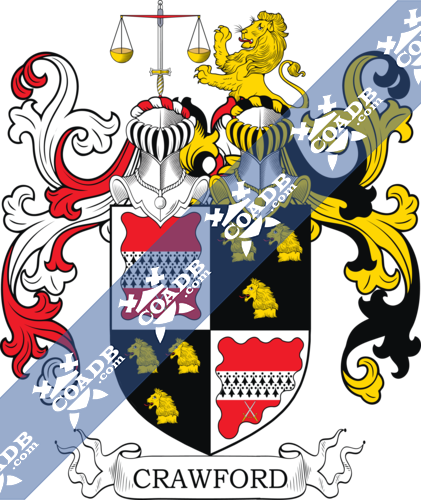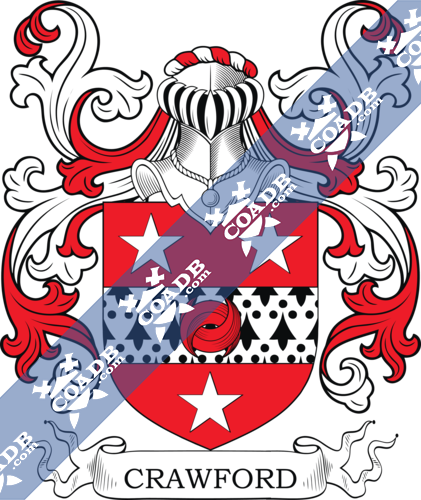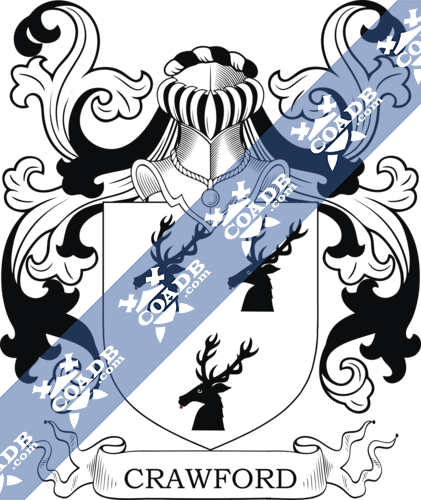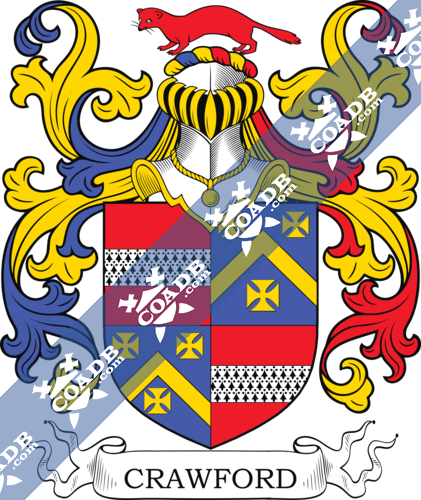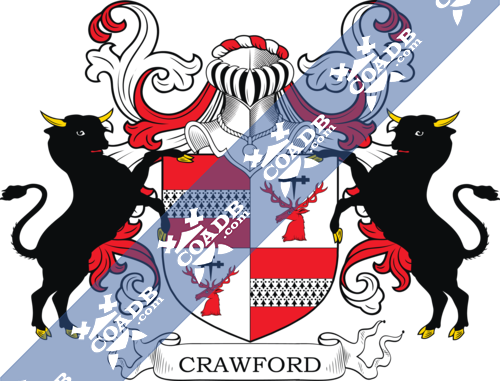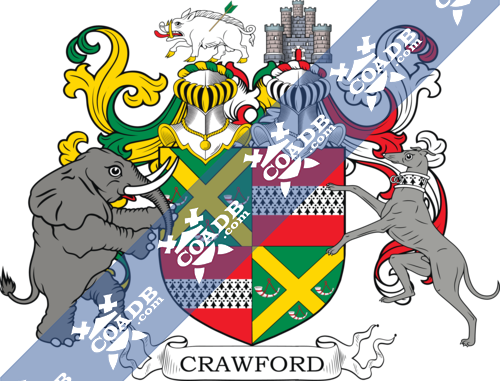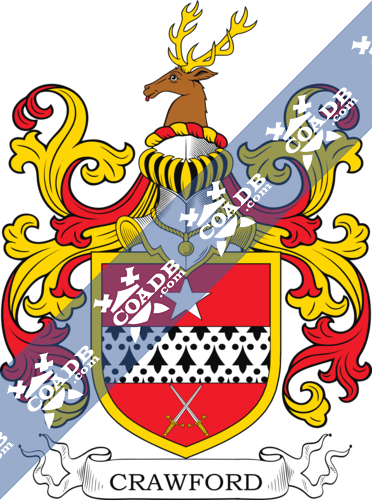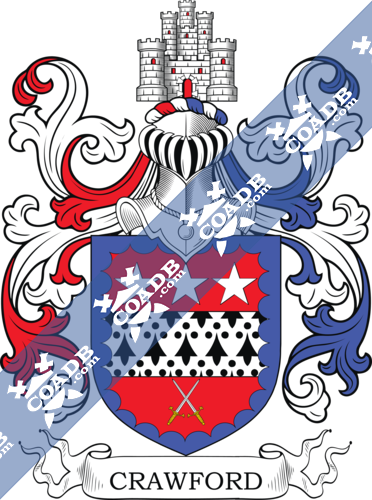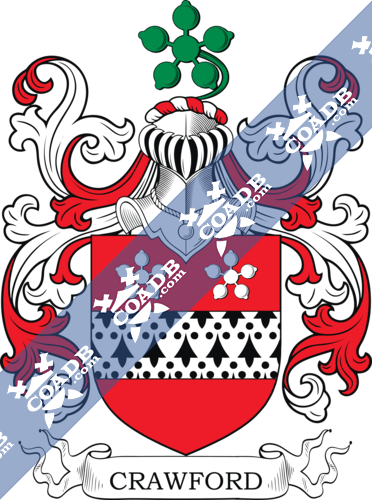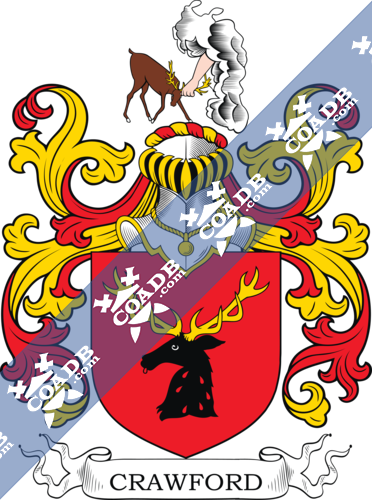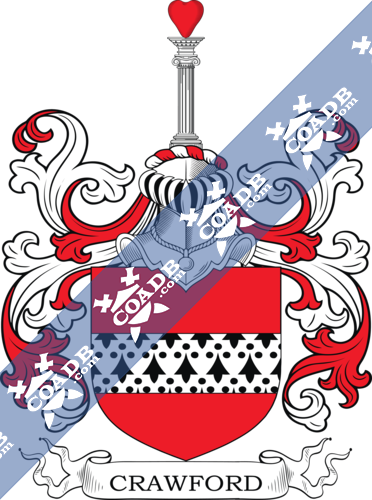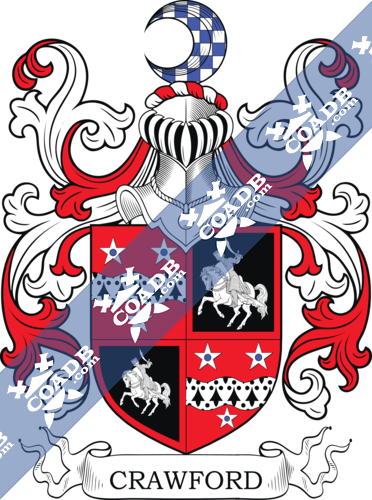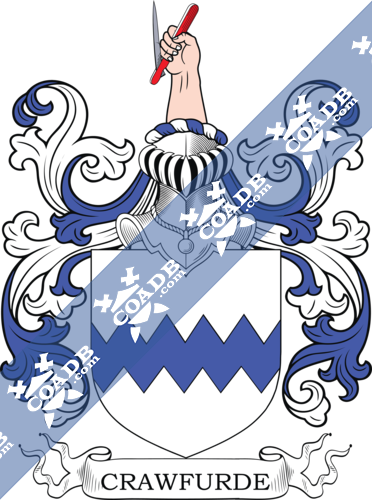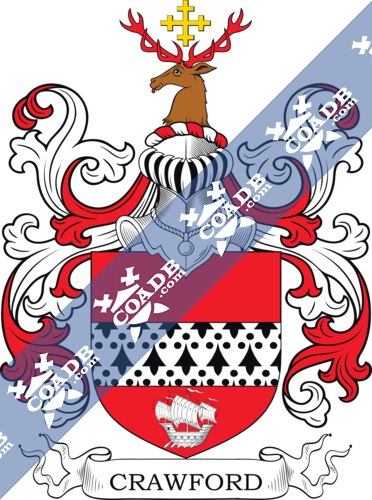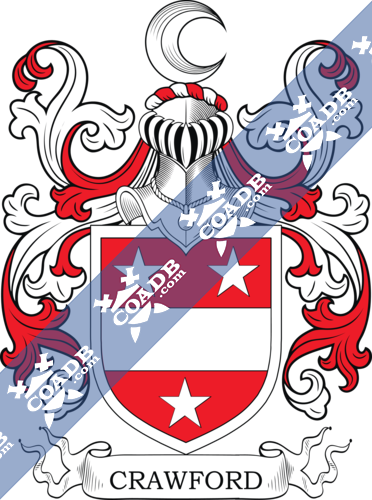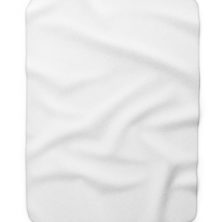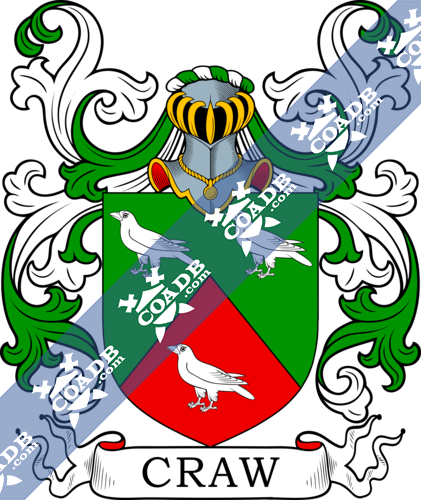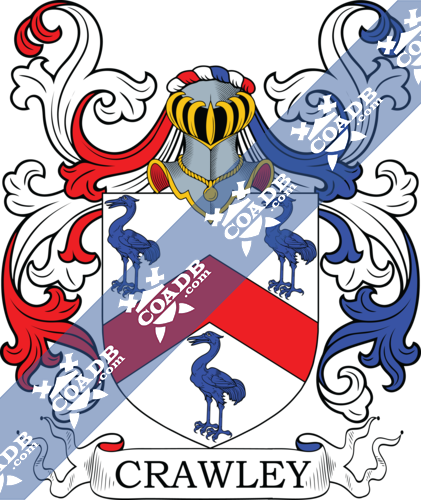Crawford Family Crest, Coat of Arms and Name History
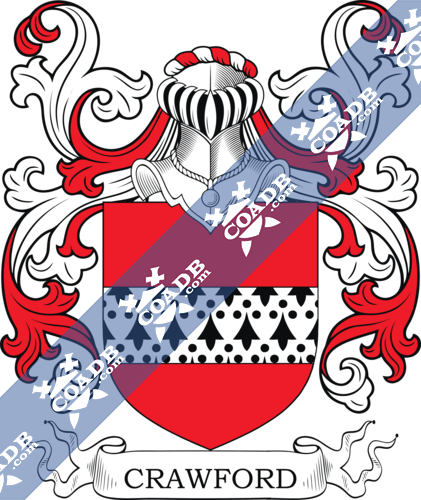
Crawford Coat of Arms Gallery
Don’t know which Coat of Arms is yours?
We can do a genealogical research. Find out the exact history of your family!
Learn MoreCrawford Surname Meaning, Origin, History, & Etymology
The most significant source of information on Crawford origins is George Crawfurd, 18th century historian. His version most closely follows the historical records and his sources were in many cases primary ones and family histories and documents. He presents the Anglo-Danish knight Thorlongus as the progenitor of Crawfords. In Durham Cathedral Library, there are reliable documents related to Thorlongus’ life that attest to his having been Overlord of Crauford at the time that surnames were adopted in Scotland during the first half of the 12th century. Thorlongus passed away between 1124 (year of his donation of lands in Ednam to the monks of St. Cuthbert) and 1136 (when the crown again had possession of those lands). Durham is the site of the monastery of the monks of St. Cuthbert, to whom Thorlongus donated the lands of Ednam. On the other hand, a different source, based on a spurious comparison between arms, presents an alternate version, that Alan, the 3rd son of Reginald the Earl of Richmond, was the progenitor of the Crawfords. It was claimed that he came to Scotland with David I upon David’s return to take the throne (1113 AD). A further story of origins was told popularly whereby one Macormack discovered the ford on the Clyde River next to where now is situated the town of Crawford; it gave him an advantage in routing his enemies. This history will review all three versions of Crawford origins as well as present genealogy of the Crawford lines of descent. The origins of the name and the Crawford relationship to other clans and families will also be discussed.
1) The Scottish last name Crawford indicates a person from the settlement of Crawford in Lanarkshire. Settlements in other parts of Scotland, Ireland and England (like Dorset and Lancashire) came later, most by Crawfords from Scotland. This is the case of the Northern Ireland Crawfords, though some others, such as those with the surname Crofoot in England, have taken on the Crawford surname without having genealogical ties to the Scottish Crawfords. There are African-American Crawfords in the US who adopted the surname from the Crawford plantation where they were slaves.
The name probably derives from Gaelic (similar to Old English and to the original Germanic language, introduced by invaders between the mid-5th and early 7th centuries AD). During that time, the Germanic invaders (traditionally known as Anglo-Saxons) spread from a couple of kingdoms in the south and east of England to encompass most of the territory of the British Isles. They became the dominant social class, exercising greater influence and power than would have logically correspond to their size within the population. The term ‘crawe’ means crow and ‘ford’ is a shallow place to cross a river. It literally translates as “ford of crows.” One can see crows rise into the skies from the trees that sit proximate to the ford of the River Clyde next to the town of Crawford. Castle Crawford sits strategically with its walls adjacent to the ford. Even today, crows feed off the fish teaming in the shallow waters of the ford. A more dramatic, though less common interpretation of ‘craw’ is ‘creu’, a term for blood in old Gaelic, suggested because it is said that the ford had been the scene of many bloody battles during preroman times and undoubtedly also responding to the resemblance between the two terms. A translation of “cattle-passage” has been suggested as a further source for the term, likely derived from ‘ford’, which classically identifies a river crossing, though the association of ‘craw’ or ‘crau’ to cattle remains unclear. The latter appears to be a late assumption from Norman (12th century) times since the term cattle comes from the French ‘chatel’.
The family is said to have originated from the old Barony of Crawford in the upper ward of Clydesdale in Lanarkshire. The House of Crawford is the Lowland Scottish custom for identifying same surnamed extended families and is the most appropriate term for identifying Crawfords, but following the modern practice, the term ‘clan’ is also used, thus the Clan Crawford Association. Following the lead of the historian George Crawfurd (lived 1681-1748), foremost researcher on Crawford history and genealogy, Crawfords adhere to the genealogies in his manuscript Laurus Crawfordiana, though there is some confusion with some of the genealogies where multiple sources provide conflicting information. He acknowledges as the Crawford progenitor Thorlongus (Thor-the-long, meaning ‘tall’), an Anglo-Danish knight descended from Vikings that invaded and settled in England several centuries before (late 9th century AD). Thorlongus may also have been of the line of Alfred the Great of England, through marriage(s) with descendant(s) of the original Danish Viking, thus making Thorlongus a possible distant cousin to Queen Margaret, wife of Malcolm (Canmore) III (who reigned in Scotland 1058-1093). Thorlongus fled to Scotland from Northumbria, where he had lands, after William the Conqueror razed the region in 1079. He fought with his distant kinsmen, the Danes, against William, in alliance with Malcolm Canmore. Probably during the late 1090s, Thorlongus settled at Ednam in the Merse on lands granted to him by King Edgar (reigned 1097-1106). Years later Thorlongus donated these lands to the monks of St. Cuthbert, giving rise to the earliest donation document in Scotland (1107-1113) by a non-royal. They are found in Durham University Library, at what had been the site of the Monastery of St. Cuthbert. Thorlongus was granted the extensive lands of Crawford by Prince David of Cambrians between 1113 and 1124, when he became King of Scotland.
Thorlongus’ probably great-grandson Galfridus was the first recorded (1168) as using the surname ‘Crauford’ as a witness to a charter in the time of King Malcolm IV, the Maiden (reigned 1153-1165). He was witness to a charter of Roger bishop of St. Andrews, confirming a donation to the monastery of Coldinghame, between 1189 and 1202. Galfridus, this great-grandson of Thorlongus was reported by George Crawfurd to have married the natural daughter of David 4th Earl of Huntington who was the youngest surviving son of Henry, 3rd Earl of Huntington, eldest son of King David I. Earl David, 4th Earl of Huntington, and was until 1198 heir to the Scottish throne. George Crawfurd presumed Galfridus to have married a natural daughter of David, 4th Earl of Huntington since the last Earl of Huntington of he Canmore line “John Scotia” calls Galfridus “frater suus” in the Cartulary of Arbroath where Galfridus is a witness to a donation. Close ties to the Scottish royal family would explain the extent of the lands granted to the early Crawfords by the throne through the reigns of Malcolm Canmore and Margaret’s sons (Edgar, Alexander and David) and their subsequent heirs and great-grandsons Malcolm IV and William. Thorlongus was also known as a formidable knight and contributed to the Scottish defense against William the Conqueror. He must have presented a fine figure as a warrior — given his imposing height — in medieval armor and mounted on a destrier (huge warhorse).
Galfridus’ son Reginald succeeded him. Sir John de Crawford, designed dominus de eodem, miles, in several donations to the monasteries of Kelso and Newbottle, succeeded his father Reginald. John died in 1248 and was buried at Melrose Abbey. He is said to have had no sons, so his two daughters, the elder of whom, Margaret, married Archibald de Douglas, who were ancestors of the Earls of Douglas. The younger daughter of Sir John is supposed to have married about 1230 a William de Lindsay (alt. David de Lindsay), ostensibly ancestor of the Earls of Crawford. There is lack of evidence for this marriage and William de Lindsay is supposed to have taken possession of the barony of Crawford before that date. It is also not clear whether this John was the same as John of Crawfordjohn or the Johannes of Crawford of that Ilk, where the senior line ended with the co-heiresses. The Cartulary of Melrose registers his death in 1248 and as where he was buried.
This Sir John may have been the one from Crawfordjohn. Different sources give conflicting information. Crawfordjohn received its name from the John who was stepson to Baldwin of Biggar. John of Crawfordjohn had at least two sons: Reginald and Gualterus (or Galfridus). Gualterus inherited the barony of Crawfordjohn. King Alexander II (reigned 1214-1249) appointed Sir Reginald Sheriff of Ayr. Reginald married Margaret, the daughter of James of Loudoun, thus acquiring that estate so preeminent in Scottish history and Crawford tradition during the 12th and 13th centuries.
Margaret Crauford, daughter of Hugh Crauford of Loudoun (the younger) and sister of Sir Reginald, the 1906 Sheriff of Ayr, was the mother of the Scottish hero Sir William Wallace. She died at Linlithgow around 1300, allegedly while Edward I of England was raiding Scotland and in the vicinity of Dunfermline. A legend has William spending time hiding in a nearby cave. Margaret was not buried inside the church due to concerns Edward would desecrated her grave. Instead, she was interred under a thorn tree on the grounds outside the church. This is the same church where the remains of Robert I (The Bruce) rest.
2) The Crawford surname is of Scottish origin. It is traced to the upper Clyde River Valley or Clydesdale in Lanarkshire, historically represented by the towns of Crawford and Crawfordjohn, and in its early history, the Barony of Crawford. The surname goes back to the 1100’s when the Barony of Crawford first appeared in Scottish records, government and ecclesiastic. The first reference to an individual being “of Crawford” was in the reign of Malcolm IV (1153-65). This surname is recognized as an independent House of Scotland with two unique arms designs, maintained since before 1196 (1296 surviving seals on the Ragman Rolls for the Lord of Loudon Castle who was also Sheriff of Ayr) and 1319 when the Crawford blazon appeared with the oldest surviving colored Scots blazons on the Scottish National Treasure, the Bannatyne or Bute Mazer. (Much of the above comes from the Clan Crawford Association website with a more complete history to be found there.)
Another version of Crawford origins that is frequently cited is the claim that the Crawfords derive from Alan Rufus, the 1st Lord of Richmond (1040-1093), and a trusted companion of William the Conqueror. He lived before the early records of the Crawfords. However, there is no reliable evidence connecting the Crawfords to the Earls of Richmond. Alan Rufus died childless. Alan Niger succeeded his brother, and likewise had no descendants. A younger brother, Stephen of Penthièvre, Count of Tréguier, was the 3rd Lord of Richmond (1058-1136). Stephen’s third son was named Alan, who became the 1st Earl of Richmond and was the father of Conan IV, Duke of Brittany. The first Earl of Richmond had no son named Alan. Conan, his heir, became the next Earl of Richmond, but mainly ruled from France, as he became Duke of Brittany. The title Earl of Richmond became extinct on several occasions but was regularly re-created in England. The only mention of an Earl of Richmond in Scotland was much later (1310). John of Brittany, 4th Earl of Richmond, was named Guardian of Scotland in the early 1300s by his uncle Edward I, title confirmed by Edward II, and in 1311 he was named Lord Ordainer during the baronial rebellion against Edward II. Some claim John participated in the Wars of Independence. He may have served in the negotiations with Scotland in 1321. Thus, the story of descent from the Earl of Richmond was likely a fiction account. Historical facts seem to show the Richmond family remained for he most part far from Scotland. There is no member that is recorded as having accompanied David I back to Scotland in 1124.
However, this version was widely distributed in Burke’s General Armory, a series of editions published between 1842 and 1884, and also in Burke’s History of the Commoners. It appears to have first been given voice about a century earlier, but no sources have been found to support the assumptions. The recording of the Arms of Colonel Robert Crawford of Newfield from the mid-1800’s state the basis of the connection being “presumptive evidence” in reference to the similarity of Arms between the House of Crawford ( ‘gules, a fess ermine’) and the Earls of Richmond (‘gules, a bend ermine’). There are problems with this formulation. Arms designs of England (Richmond) and Scotland (Crawford) were independent with no prohibition against similarity. In fact, early manuscripts on arms from England show several families using the same arms as the Scottish Crawfords, with only minor distinctions between them. Their surnames bear no relationship to Crawford, though they show the arms ‘gules, a fess ermine’ in various forms. One of these is a family surnamed Wallis who used the same arms, to be found in “The Dering Roll”. What most speaks against against the validity of this version of Crawford origins and rests credibility from it is that Thorlongus is named as Overlord of Crawford in the Durham Cathedral documents dating from the early 1100s, during the reign of King Edgar. Thus, credible evidence exists for Thorlongus being the progenitor of Crawfords, while there is no corresponding support for any Crawfords descending from the Earl of Richmond. Reliable evidence indicates Thorlongus was the Overlord of Crawford at the time the use of surnames was introduced in Scotland, and it came into use by residents of Crawford around that time. Initially the use of surnames followed the French custom of indicating the location of a person’s home, where they came from. In conclusion, the evidence predominantly supports the view that Thorlongus was the ancestor of the Scottish descent lines that bear the surname of Crawford.
A third popular but likely fanciful origins story involves one Macormack who attained prominence by discovering a ford on the waters of the ‘Cree’ [the Clyde? or perhaps an ancient name for the locale]. This discovery gave him and his party a distinct advantage so that he routed his enemies. In celebration, he changed his name from Macormack to “Creeford”, which over time evolved to Crawford. Variants of the tale identified the enemy as Roman or another local tribe. This version of Crawford origins, though quite popularly known, suggests local lore. It may even go back beyond recorded history, and it probably belongs to oral tradition. In any case, the source of this tale is unknown.
3) The issue of the relationship between Crawfords and Lindsays has been a confusing one that has led to considerable misunderstanding, and thus it is important to clarify. In today’s modern online world, there is a lot of information but also much misinformation. The Crawfords held the extensive lands of the barony of Crawford in Lanarkshire from the time of Thorlongus, his sons and grandsons granted by the successively ruling sons of King Malcolm ‘Canmore’. That is where they resided and from where they took the surname of Crawford. Crawford history attributes the Lindsay acquisition of the Crawford Barony by William Lindsay’s marriage around 1215 to the younger daughter of Sir Johannes Crawford, knight, who died in 1248. Some sources give his name as Hugh Crauford.
What we know for sure is that Robert II gave the title of Earl of Crawford to David Lindsay when he created the Peerage in 1398. Robert II was Robert the Bruce’s grandson by his daughter Marjorie and Walter Stewart, the 6th High Stewart of Scotland. David Lindsay married Robert II’s daughter Elizabeth. However, Crawfords are an independent House of Southern Scotland. They have never been a part of Clan Lindsay (or any other house or clan) nor acknowledged the Earl of Crawford as chief. Crawfords have had their own head of House, the Laird (and sometimes baron) of Auchenames, as it was the senior line of the House of Crawford (or Craufurd as it is spelled in Scotland). Any affiliations with other clans have been strictly through the marriages alliances of Crawfords to women from other houses and clans, and vice-versa, of Crawford women marrying out into other houses and clans. Crawfords have never been a “sept” of another house or clan. The House of Crawford never had septs either. That is a practice that prevailed in the Highlands, not Lowland Scotland.
Clan Crawford Association maintains that the name Crawford can be traced to “the upper Clyde River Valley in Lanarkshire, historically represented by the towns of Crawford and Crawfordjohn, and in its early history, the Barony of Crawford. The surname goes back to the late 1000’s when the Barony of Crawford is noted in local, royal, and ecclesiastic records. The first reference to an individual being “of Crawford” was in the reign of Malcolm IV (1153-65). This surname is recognized as an independent House of Scotland with two unique arms designs, continually maintained since before 1196 (surviving seals of the Lord of Loudon Castle who was also Sheriff of Ayr) and 1319 when the Crawford shield appeared with the oldest surviving colored Scots blazons on the Scottish National Treasure, the Bannatyne Mazer”. They state, “In the Merse, around 1090, begins our family’s history in Scotland. Thorlongus was given undeveloped lands in a place called Ednam, just west of Berwick and north of the River Tweed”. There are records that state that Thorlongus founded Ednam, a land that was granted to him by King Edgar (reigned 1097 to 1107) of Scotland, “to develop and populate”. Around the edge of Thorlongus’ seal is a Latin inscription that states ‘Thor me mittet amico’ that can be translated as ‘Thor will send/bestow my [meaning Thor’s] friend’. The seal was granted with the mark of royal distinction and it probably refers to the friendship between Thorlongus and either King Malcolm III or his son King Edgar. By early 12th century, Thorlongus had settled in Crawford. He was known as the Overlord of Crawford. The first actual recording of the surname was with Thorlongus’ great-grandson, Galfridus de Crauford (witness to a charter in 1168 during the reign of King William, brother and successor to Malcolm IV).
Spelling Variations
The most common variations in the spelling of Crawford are as follows by order of frequency of use: Crawford, Craufurd (in Scotland), Crawfurd, Crafoord (Sweden), Crafford (Netherlands & South Africa), Crofford (variant, most commonly found in the US), Crauford (old), Craufuird (ancient), Krafort (1600s in Scotland and Sweden), Crowfoot (England).
Popularity & Geographic Distribution
The last name Crawford ranks 146th in popularity in the United Status as of the 2000 Census. The name ranks particularly high in the following six states: Georgia, Ohio, South Carolina, Missouri, Oklahoma, and Tennessee.
The surname Crawford frequency/commonness ranks as follows in the British Isles: England (309th), Scotland (77th), Wales (409th), Ireland (719th) and Northern Ireland (58th). In England, it ranks highest in the counties of Northumberland and Durham. In Scotland, the surname ranks highest in Bute, Renfrewshire, and Ayrshire. In Wales, it ranks highest in Merionethshire and Brecknockshire. In the Republic of Ireland, it ranks highest in county Donegal. In Northern Ireland, it ranks highest in county Antrim. The surname is also present throughout the remainder of the English-speaking world: Canada (239th), New Zealand (105th), Australia (191st), and South Africa (977th).
Early Bearers of the Surname and Ancestors of the line
One of the early bearers of this surname was John or Johannes de Crauford who was listed in the Records of the Abbey of Kelso around 1147 AD. The Hundred Rolls of 1273 AD, a census of Wales and England, known in Latin as Rotuli Hundredorum lists two bearers of this surname: Nicholas de Crauford (Somerset) and Robert de Crauford (Oxfordshire). An early baptism involving this surname was Anne, daughter of John Crawford, at St. James Clerkenwell.
Crawford lore traces another early ancestor of the Crawford line back to a 9th century Danish Viking who invaded the coast of west central England in the kingdom of Mercia. It is a Crawford tradition that has their direct ancestor being a younger son of the King of Denmark and one of the leaders of the invading Viking forces into England. He settled in Mercia and married into the ruling family.
The earliest male Crawford ancestor mentioned by name may have been Leofwine, who appears in a dedicatory charter by his son or brother Thorlongus. There is a contested reading of the citation in Thorlongus’ dedication. What was originally read as “father” (‘patrie’) may really refer to his brother (“fratrie”). The smudging of the first letter of the word makes it difficult to know for sure if the first letter(s) is a ‘p’ or a ‘fr’. The use of a microscope to help decipher this might be helpful. We know Thorlongus had a brother by the name of Leofwine who was a monk at Kelso. But whether the dedication was to his father or to his brother, who had died fairly close to the date the document was redacted, is not known for sure.
Thorlongus seems to have had land holdings in Northumbria, maybe inherited from his father. In 1069 Thorlongus fled to Scotland when William the Conqueror overran Northumbria in an action known as “The Harrying of the North”, a campaign waged during the winter of 1069-70 to subjugate northern England and complete the conquest. He eventually settled in the Scottish district of Merse in a town called Ednam.
Crawford Family Tree & Crawford Genealogy
The following is a discussion of a dozen of the different noble and landed families bearing the Crawford last name. Recent research has identified over 400 estates that have been held by Crawfords over the centuries since the advent of surnames (c. 1124). Nevertheless, most have belonged to just a few Crawford cadets (lines associated with specific estates). A very few were held for centuries, others for just a few years. Death taxes became substantial, especially in the last several centuries, thus making it difficult for families to continue to hold on to property over many generations. At the end of the genealogy section is included a statement on the arms of each family. Much of that information is found in Raymond Crawfurd’s analysis titled “Arms of Branches of the Crawfurd Family” and published by the Clan Crawford Association in its 2nd volume of books on the House of Crawford.
Craufurds of Crawfordjohn
Crawfordjohn is a small town some 10 miles west from the town of Crawford. The church of Crawfordjohn is now a heritage site and museum. There was a chapel there in the 12th century and the location seems to have been used for religious purposes even before Christianity was introduced. The chapel and later the church were dependent on Kelso Abbey. The current church was built during the 19th century. The first castle may have been built as early as the 12th century, though it has long disappeared. Several others were built successively. The castle site is known as Boghouse. Foundation stones are still visible on the hillside near the town.
Crawfordjohn was first identified as the property of John Crauford, the son of Sir Reginald Crauford, a grandson of the Galfridus, the great-grandson of Thorlongus. John is best known as the stepson of Baldwin of Biggar, Sheriff of Lanark (c. 1155) who had married John’s widowed mother, the widow of Reginald. John figures in three documents of the time: 1) he witnessed a Douglas charter with his stepfather Baldwin on a date between 1147-1164; 2) he appears in the Lindsay Charter of Fingland at Newbottle Abbey sometime between 1180-1190; and 3) he appeared in King William’s (reigned 1165 to 1214) conference at Kelso on July 4, 1195 (Crawfordjohn is there called “ville Johannis privigni Baldwini”, “privigni” meaning “stepchild”, thus the phrase translates to “town of John, stepson of Baldwin”). [The range in dates corresponds to the fact that no actual date is given, only the name of the reigning king at the time the charter was composed.]
Crawfordjohn stayed in the hands of John de Crauford’s descendants for only a few generations, when a Crauford heiress married a Barclay. It came back into the hands of Craufords in 1481 with the marriage of Malcolm Crauford to the Kilbirnie heiress Marjory Barclay.
Ultimately, most Crawfords appear to descend from Crawfordjohn via Loudoun. Little is known of the Dalmagregan Branch or even early Crawfordjohn. The Kilbirnie line appears to have died out, as have many of the prominent old cadet lines including the main line of Auchenames, and Cartsburn and Greenock.
It is unknown where and when ‘gules a fess ermine’ was introduced as the basic arms of Crawford. It may have been during the preeminence of Crawfordjohn, or later at Loudoun. The earliest coat of arms associated with Crawfords is the Templar cross, which was described as the arms of Sir Reginald, father of John of Crawfordjohn. These were not personal arms, since their use was generalized to all Templars, but that Sir Reginald used them suggests that he may have been a Templar knight.
Craufurds of Loudoun (and some descendant cadets)
The Register of the Abbey of Kelso documents, in 1153 AD, one John, stepson of Baldwin de Biggar (ancestor of the Earls of Wigtown), who owned the northern part of the Barony of Crawford, later known as Crawfordjohn. One of his sons was Sir Reginald de Crauford, 1st Sheriff of Ayr, born in 1165 AD. Sir Reginald married Margaret, daughter and heir of James of Loudoun, and they had four sons. John had another son named Galterus, who inherited the paternal estate but his line ended in co-heirs shortly before 1259 AD. One married a Barclay transferring Crawfordjohn, or at least large part of that estate, to the Barclay family of Kilbirnie.
Sir Reginald’s son, Hugh Crauford, inherited his mother’s property of Loudoun and also acquired grants in 1226 and 1228 AD from Alan, Lord of Galloway, for the lands of Crosbie and Monnoch. Sir Reginald’s son John ostensibly received lands in Clydesdale. This John’s son, also John, obtained by marriage an estate called Ardach, which was renamed Craufurdland. Adam, another son of Reginald, became a clergy. Of William, the youngest, little is known, though he may have been the ancestor of Sir William Crawford, cousin and companion to Sir William Wallace.
The Loudoun pedigree continues as follows:
Hugh Crauford, the younger, (married Alicia, had a charter of the lands of Draffen in 1271 AD, left a daughter named Margaret who was the mother of Sir William Wallace);
Sir Reginald Crauford (Sheriff of Ayr in 1296, married Cecilia, may have been murdered by an English garrison at the Barns of Ayr, also known as the Black Parliament);
Sir Reginald Crauford (follower of Robert the Bruce during his early years of conflict with Edward I, lead an incursion to Galloway in the winter of 1306-07 with the younger brothers of Robert the Bruce, Thomas and Alexander, that was captured by allies of the English, subsequently executed by the English at Carlisle in February 1307);
Susan Crauford (niece of the above, daughter of Andrew, married Sir Duncan Campbell of Reidcastle (1318), female progenitor of the Earls of Loudoun);
Hugh Crauford (son of Hugh the younger, above, inherited Crosbie, progenitor of Auchenames);
Reginald Crauford (son of Hugh, immediately above, granted produce of Ormshugh, considered first of Auchenames, died c. 1358);
Reginald Crauford (son of Reginald immediately above, witness to a charter in 1358, gets Craigenfeoch);
Thomas Crauford (son of Reginald immediately above, endowed a chapel at Kilbarchan in 1401);
Archibald Crauford (receives Previck and Thirdpart in 1427, married Agnes Galbraith);
Robert Crauford of Auchenames (died at the Battle of Flodden 1513);
Thomas Crauford (inherited Auchenames in 1534, married Marion Montgomery);
John Crauford (married daughter of Giles Cunningham 1544);
William Crauford of Haining (descendant of Sir William Crauford, cousin and companion of Sir William Wallace, hero of Scotland;
James/David Crawfurd of Baidland (mentioned 1546, descendant of William Crauford of Haining);
Andrew Crauford of Baidland (mentioned 1552 & subsequently);
Andrew Crauford of Baidland (married daughter of Laurence Crauford of Kilbirnie);
James Crawfurd of Baidland, bought Ardmillan estate, married Marjory Kennedy, daughter of Hugh Kennedy of Ardmillan);
William Crauford (tenant of the lands of Drings);
Andro Crauford (acquired the lands of Drings, married Marion Cathcard, had two sons: William, whose male line failed after four generations and George below);
Reverend George Crauford (Minister of West Kilbride, married Agnes, daughter of John Montgomery of Bridgend);
Robert Crauford (married Agnes Kennedy of Balsarroch);
James Crauford (acquired the lands of Newark in 1687, married Ann, daughter of Quentin Kennedy of Drummellane).
The arms of Craufords of Loudoun we know were ‘gules a fess ermine’ since they were attached to the Ragman Roll. It includes the first physical representation of the arms of Sir Reginald Crauford (1296 Sheriff of Ayr). Crawford of Haining have as Arms: Gules, a fess ermine, and in dexter chief a mullet argent. A later version (1370-1678) of arms had gules, a fess ermine between 2 mullets in chief argent and a stag’s head in base couped or attired sable.
Crawfords of Terringzean and Crawfuirdstone
The Craufords of Terringzean (also Tarinzen) are first recorded in the Exchequer Rolls of 1438, but the property was likely held for two to three centuries before. By 1467, they no longer had this property. They also held nearby Lefnorris where Dumfries House now stands. This estate became known as Craufordstone. It may have been exchanged for the original Dalmagregan grant of land at Crawfordstoun in Nithsdale near Moniaive in Dumfries. The genealogies for this cadet are somewhat contradictory, but it is generally considered to be Dalmagregan in origin, that is descended from Sir Gregan Crauford of Crawford. It is considered the ancestor of the succeeding Dalmagregan cadets that include Dalegles, Beaux, Drongan, Lochnoris (also Lefnoris), Hirshell, Kerse (or Carse) and Drumsoy. The recorded genealogy goes from Edward Crauford of Tarinzen in the time of Robert II, to his son John Crauford of Tarinzen (witness in 1421), a line that became extinct shortly thereafter. Edward had a brother Roger titled Lord of Dalegles (mentioned in 1384). Roger had a son John (mentioned in 1407). John had two sons, Roger (mentioned in 1446 & 1452) and George of Beaux. From the Crawfords of Beaux descended the Craufords of Lochnoris. John Crauford of Hirshell married Margrat, daughter of Lord Cathcart. Their son, also John Crauford of Drongan, in 1543 married Margrat, daughter of Bartholomew Crauford of Kerse. John and Margrat had three children: George Crauford of Drongan (retour 1547), Jean, and Marion who married Thomas Kennedy of Ardmillan. George married Marion, daughter of George Crauford of Lochnoris. The estate of Drongan passed to Lochnoris. There is some variation in descent between sources from Roger (1384) to John (mentioned in 1407), to William of Beaux, but otherwise it follows the same evolution. George Crawfurd seems to think that it is a very early cadet of Loudoun, which would speak against it being Dalmagregan. However, it has also been attributed to the latter, with origins in the Crawfordstoun of Dumfries, which was the original estate supposedly granted to Sir Gregan by David I.
The arms of the Dalmagregan Craufords are clearly documented since the privilege to use them were awarded to Sir Gregan Crauford by David I around 1127 after David’s rescue by Sir Gregan from the attack of a wild stag at the site where Holyrood Abbey was built in commemoration the following year.
Craufurd of Auchenames
The lineage or ancestry of this branch of the Crawford family tree traces back to Sir Reginald de Craufurd of Loudoun, 1st Sheriff of Ayr, who c. 1200 AD married Margaret de Loudoun, daughter and heiress of James de Loudoun, who had received a Charter of the Barony of Loudoun, Ayrshire, Scotland, from Richard de Morville. Sir Reginald became the first Vicecomes of that county. He died in 1226 AD and was succeeded by his son Hugh. This son, Hugh de Crauford of Loudoun, may also have been Vicecomes of Ayrshire (2nd), though no documentary evidence has survived to confirm it. He witnessed a charter in 1226 AD. Hugh died in 1246 AD. His eldest son, also named Hugh, succeeded him. Hugh the younger married a woman named Alicia of Draffen (born c. 1230) and had issue Reginald and Margaret. Margaret married Sir Malcolm Wallace of Eldersley, having a son named William Wallace (c. 1270-1305), the famous Scottish patriot depicted in the movie Braveheart. Hugh died in 1288 and was succeeded by his son Reginald. Sir Reginald Craufurd of Loudoun, Vicecomes de Ayr (1296). In the epic poem by Blind Harry, “The Wallace” Sir Reginald is depicted as having been murdered by the English at a false banquet at the Barnes of Ayr in 1297 AD. It is unknown whether this is an accurate representation of events. It may not have been, though there were certainly ugly incidents of this nature during the Scottish Wars of Independence. Reginald apparently had a son and heir who was named Reginald, too. This last Reginald’s niece Susan, daughter of Andrew Craufurd of Longemertenock, married Sir Duncan Campbell of Redcastle and from this marriage descended the Earls of Loudoun. This last Reginald Crauford of Loudoun died at Carlisle executed (drawn and quartered, then beheaded) by the English in 1307. It was the same fate suffered by his cousin Sir William Wallace in London two years earlier.
The male line of the Loudoun Crauford family was carried on by Sir Hugh Craufurd of Crosbie, a younger son of Sir Reginald the 1296 Sheriff of Ayr (possibly Rodulfus at the Oath of Norham of 1291). Hugh’s son Reginald obtained an annuity grant from the estate of Ormshugh from Robert the Bruce in 1320 and also was granted an augmentation to his arms of ‘gules a fess ermine’ with ‘two lances in saltire’ commemorating exploits at Bannockburn. This Reginald may later have received the lands of Auchenames, Renfrewshire, at least that is the traditional belief. His son Reginald (witness to a charter in 1352) was his successor, followed by his grandson Thomas of Auchenames and Crosbie. Thomas Craufurd, the first documented as of Auchenames (Kelso Abbey donation charter of 1401 commemorating his grandfather and his king Robert II). Thomas ostensibly died in 1465, though it may have been his son by the same name. Thomas had a brother John who sometimes is referred to as being the one who married the daughter of Malcolm Galbraith of Greenock. In any case, their son also Malcolm married Marjory Barclay of Kilbirnie and in this way that estate came under Craufurds. From Malcolm and Marjory descend the Craufurds of Kilbirnie and later through Sir Thomas Craufurd (6th and youngest son of Laurence of Kilbirnie and Janet Ker, eldest daughter of Robert Ker of Kersland), his descendants, the Craufurds of Jordanhill. Captain Thomas Craufurd, a figure of considerable military exploit and fame, Head of the Guard of Mary de Guise, mother of Mary Queen of Scots, Captain of the French King’s Scottish Guard during Mary’s minority in France, and upon Mary’s return to Scotland, accompanied her and named as secretary to Lord Darnley, Queen Mary’s husband. Thomas was later advisor to the young King James VI of Scotland. [James went on to inherit the English throne of his first cousin once removed Elizabeth I, reigning as James I of England. It was James who finally united the Crowns of Scotland and England.] King James awarded Capt. Thomas with several grants of land for his military successes against the Loyalists of James’ mother Mary, including the capture of Dumbarton Castle, which involved a daring climb up a cliff with 150 troops to reach the castle fortress. Thomas was an early convert to Protestantism.
George Crawfurd systematized most of the Crawford genealogy, including that of Auchenames. There is some inconsistency, which he mostly acknowledges providing the sources. Thomas Crauford married Margrat, daughter and heiress of Malcolm Galbraith of Easter Greenock. They had a son Archibald, who in 1427 received Thirdpart [often found written as Thridpart]. Archibald of Auchenames seems to have married Margrat Douglas, daughter and co-heiress of Sir William Douglas of Peircetoun. Archibald exchanged his part of the Kelly estate for Privick and Drumvier in 1444. He died in 1459. Archibald’s son Robert married Marion Houston in 1483 and that same year he passed the estates on to his son James. James married Isobel Semple. Robert and Marion had two other sons Henry and Robert. Robert fought alongside King James IV of Scotland at the battle of Flodden (1513 AD) where he was killed.
Robert’s eldest son and heir, Thomas Craufurd, married Marion, daughter of Montgomery of Hazlehead, and had three sons with her. The eldest son was John. John married Giles Cunningham’s daughter around 1544. His son William married Annabella Chalmers. John Craufurd of Auchenames died at the Battle of Pinkie in 1547 without posterity, at which point the estates devolved on his brother William. William Craufurd married Annabel, daughter of Chalmers of Gadgirth, and had one son with her named James who in 1579 married Lady Elizabeth Cuninghame. James Craufurd succeeded to Auchenames in 1498 and got a charter for Corsbie (Crosbie). James had a daughter named Jane, who in 1606, married Patrick Craufurd of Crosbie, and with that marriage, the ancient family estates of Crosbie and Auchenames were reunited. William had died in 1582 whereupon the Barony of Auchenames reverted to the youngest brother, Patrick who married Jean Fisher and inherited Auchenames from his nephew James. They had a son also Patrick who married a daughter of John Frazer, third laird of Knock, and had a son and successor named William. In 1587, William married Margaret, daughter of Sir Patrick Houstoun, and had a son with her also named Patrick, who was his successor. This Patrick married Jane Crauford, daughter and heiress of James Craufurd, and thus again united the ancient estates of Crosbie and Auchenames. They had several children, including William. The son William Craufurd of Auchenames married Anna, daughter of Lamont of Innertone, Argyllshire, Scotland, and had four children with her: 1) Archibald (heir), 2) a daughter (married Mr. Houston of Houstoun), 3) a 2nd daughter (married Mr. Kennedy of Kilbenzie), and 4) a 3rd daughter (married Mr. Boyd of Trochrig). As you can see, there was considerable intermarrying between a few tightly related families.
The son and heir of Auchenames and Crosbie, Archibald was the 16th Baron. He married Margaret, daughter of Porterfield of that ilk, and had with her a son William (who married Helen, daughter of Sir Thomas Burnet of Crimond). This couple had several children but died without a male heir. Since Archibald left no male heirs, the estates of Auchenames and Crosbie were brought to judicial sale in 1715, during the minority of his granddaughter, and were purchased by Patrick Craufurd, Merchant of Edinburgh and son of David Craufurd of Drumsoy. The second daughter, Jane Craufurd, of Auchenames and of Crosbie, by an arrangement made in 1695 on the death of her only brother, married Patrick Craufurd of Edinburgh (mentioned above), who afterwards inherited Drumsoy. They had issue: 1) Patrick (heir to Auchenames and Drumsoy), 2) George (Lieutenant Colonel of the 53rd Regiment, married Anne, daughter of Edward Randal, Esquire, of Salisbury). George had seven children: 1) Mary (married Thomas Gilbert, Esq., M.P), 2) Patrick George (in 1776, married Jean, daughter of Lieutenant Colonel Donald MacDonald, who had children named George, John, William Petres, Captain Donald, Margaret Randal, and Catherine Mary), 3) Ronald (of Restalrig, in 1743, married Catherine, daughter of John Forbes of Newhall, had issue named Patrick, Margaret, Jane, Annabella, and Catherine Forbes), 4) James (prominent merchant in Holland, married Elizabeth Andrews of Rotterdam, had as issue Patrick, James, George, Ronald, and Margaret), 5) Hugh (Merchant in the East Indies), 6) Alexander (an officer in the army, died in Lord Cathcart’s expedition to Carthagena in 1741), and 7) John (an officer in the army, attained rank of Lieutenant-General). Their children married widely into prominent Scot families that tied Crawfords closely to them. Patrick died in 1733 and was succeeded by his son Patrick.
This son, Patrick Craufurd of Drumsoy and Auchenames was a Member of Parliament for Edinburgh in 1741 and 1747, as well as for Renfrewshire in 1761. He married Elizabeth, daughter and co-heir of George Middleton, Esq., Banker of London, and had two sons with her: John and James. He died in 1778 and was succeeded by the elder son John. John Craufurd of Drumsoy and Auchenames was a Member of Parliament for Old Sarum in 1768 and later for Renfrewshire in 1774. Son James was named Conservator of Scottish Privileges and moved to the Netherlands, where he had a large family. A brother and his son succeeded to this post, which was based in Veeres, Zeeland, Holland. Patrick died in 1814 without posterity and thus was succeeded by his cousin, also named John.
John Craufurd, Esq., of Auchenames and Crosbie (born 1780) was a Justice of the Peace and Deputy Lieutenant. In 1814, he married Sophia Marianna, daughter of Major-General Horace Churchill, and had issue: Edward Henry John (discussed below), Frederick Augustus Buchanan (Admiral in the Royal Navy), Robert Emilius Fazakerley (Lieutenant Colonel of the Royal Army), George Ponsonby, Katherine Horatia, and Georgiana Janet (married Count Marco Auerlio Saffi, one of the Triumvirs of the Republic of Rome). He died in 1867 and was succeeded by his eldest son Edward. Edward Henry John Craufurd, Esq., (born 1816) of Auchenames in Ayrshire, Justice of the Peace, Deputy Lieutenant, and Member of Parliament for the Ayr District of Burgh, an M.A. and a Barrister-at-Law. In 1863, he married Frances, daughter of Reverend William Molesworth, Rector of St. Brooke, and had four children with her: Hugh Ronald George (1873), Mary Beatrice (1864), Katharine Yseult (1866), and Frances Guenevere (1868). In 1904, his heir Hugh, as the new Laird of Auchenames sold all the properties pertaining to that estate including Crosbie and immigrated to Canada. He had a daughter Clare, but no male progeny. Hugh died in 1942 in Calgary where he and his family had settled. His only grandson, Frederick Boalch, son of Clare, attended Mount Royal College; then he joined the Royal Canadian Air Force. He died during a military air-training mission over Canadian waters on 12 Feb 1945, the day of his 21st birthday. With his passing, the long-lived and illustrious senior line of Craufurds of Auchenames ended.
One of the Craufurd of Auchenames Coat of Arms has Quarterly, 1st and 4th, argent, a stag’s head erased gules between his attires a cross-crosslet fitchee sable; 2nd and 3rd gules, a fess ermine, surmounted of two lances in saltire argent, the augmentation granted by Robert the Bruce to Sir Reginald Craufurd in 1320. Crest: A stag’s head erased gules between the attires a cross-crosslet fitchee; 2nd, a phoenix proper rising from the flames. Supporters: Two bulls sable armed and unfurled or. Mottoes: “God shaw the right” and “Tutum te robore reddam”. The family’s seat was Auchenames House, West Kilbride.
Baronetcy of Kilbirnie
The line of Sir Robert Craufurd, current Baronet of Kilbirnie, is brought forward since they were actually from Thirdpart, which is a cadet of Auchenames. The Auchenames line died out with the death of Hugh Ronald George Craufurd. Sir Robert is the current identified most senior member of Auchenames, though through the cadet lines of Thirdpart and Previck. Sir Robert’s line (2nd baronetcy) does not descend from Kilbirnie. That line is possibly extinct, though there may be descendants in Northern Ireland and/or America.
The 1st Baronetcy of Kilbirnie was conferred upon John Crauford of Kilbirnie in 1628. In 1662, the baronetcy became dormant, with John’s death, until 1765 when Hew Crawford was made the second Baronet. He married into the Pollock family and assumed the surname Pollock to inherit the Pollock estates. The baronetcy lapsed in 1885. A condition of the Craufurd baronetcy was that the titleholder must bear the surname Craufurd. A second incarnation of the baronetcy was conferred upon Alexander Craufurd of Newark [cadet of Auchenames] in 1781. He had 3 distinguished sons. The first was Sir James Craufurd who was the British Ambassador in Germany from 1798 to 1803. The second was Lieutenant-General Sir Charles Gregan-Craufurd (1761-1821) who served with great courage and daring in the Netherlands in 1794. The third was Major-General Robert Craufurd (1764-1812), “Black Bob” Commander of the Light Division in the Peninsular War. The current Baronet of Kilbirnie is Sir Robert J. Craufurd, the 9th. He resides in Lymington, England. Robin, as he is known, has been identified by House of Crawford research as the senior most documented living member of The House of Crawford. Their extensive history of the Baronetcy of Kilbirnie is summarized below:
James Crauford of Auchenames’ son was Quentin Craufurd of Newark. He was a justiciary Baillie for the West Seas of Scotland. In 1729, he married Ann, daughter of James Robinson or Irvine, and had several children including two sons: Alexander (see below) and Quentin (made a fortune in India and settled in Paris, reportedly helped Queen Maria Antoinette with her failed escape). The elder son, Sir Alexander Craufurd, 1st Baronet, was so created in 1781. In 1760, he married Jane, daughter of James Crokatt of Luxborough, Essex. He had issue, including the following sons: 1) James (2nd Baronet), 2) Sir Charles Gregan (Member of Parliament, Lieutenant-General in the Army, married Anna Maria, daughter of the 2nd Earl of Harrington), 3) Robert (Major-General in the Army, commanded the Light Division in the Peninsula War, died at the assault of Ciudad Rodrigo. He married Mary Frances, daughter of Henry Holland of Hans Place; they had four children, Louisa Mary Frances, Reverend Charles Henry Gregan, Robert Gregan, and Daniel. Sir James Gregan-Craufurd 2nd Baronet (born 1761), assumed the name and arms of Gregan in 1812 under the mistaken idea that he was a direct descendant of Sir Gregan Craufurd. In 1792, he married Maria Theresa, daughter of General Thomas Gage, and had four children: 1) Thomas Gage (Office in the Guards, killed in action at Hougoumont in 1815), 2) Alexander Charles (Lieutenant Colonel in the Army, married Barbara, daughter of 7th Earl of Coventry), 3) Sir George William (3rd Baronet), and 4) Jane (married General Christopher Chowne and later Reverend Sir Henry R. Dukinfield). Sir James was succeeded by his third, and only surviving, son George. This son, the Reverend Sir George William Craufurd (born 1797), 3rd Baronet, was a Fellow of King’s College Cambridge. In 1843, he married Hester King, daughter of the 7th Baron King, and had two sons with her: Sir Charles William Frederick (4th Baronet) and Henry Thomas Gage. Sir George died in 1881 and was succeeded by his son, Sir Charles William Frederick Craufurd (born 1847), 4th Baronet of Kilbirnie, Stirlingshire, Scotland, and Lieutenant Commander of the Royal Navy. In 1870, he married Isola Caroline Vereker, daughter of 4th Viscount Gort, and had ten children with her as follows: 1) George Standish Gage (5th Baronet, see below), 2) Quentin Charles Alexander (Captain Royal Navy, married Anne Blackwell), 3) Alexander John Fortescue (born in 1876, Ceres, Cape Province, South Africa, married Alexa Campbell, daughter of Robert Little of Singapore), 4) Charles Edward Vereker (Commander of the Royal Navy, married Sonia, daughter of S. Russell of Stirling House in Clapton Common), 5) Robert Henry Dunkinfield, 6) Hester Jane Leslie, 7) Laline Isolda (Shotley Hall, Northumberland, married High Walton Wilson and later Frederick Thomas Clifton Crump of the Manor House, Cleobury Mortimer, Shropshire), 8) Isolda Mabel Cecil (married Geoffrey Parker, son of Cecil T. Parker, had children), 9) Eleanor Mary Dorothea (married Charles Thackeray Wilbraham, son of Henry), and 10) Margaret Elizabeth Maria (in 1918, married Professor Owen L. V. Simkinson de Wesselow, son of Reverend C. H. de Wesselow, had children). He died and was succeeded by his son George in 1939. Sir Standish George Gage Crauford, 5th Baronet, of Kilbirnie, Stirlingshire, Scotland, was born in 1872. He was a Justice of the Peace, Deputy Lieutenant, and Brigadier-General who served in Tirah, the South African War, the Frontier Force, the Persian Guld, and in World War I (where he was wounded three times). In 1923, he married Ellen Alexandra, daughter of Captain Alexander Price Haig of Blairhill.
The coat of arms for the Baronet of Kilbirnie are Argent proper 2 lances saltire between four spots of ermine sable with a bordure chequy gules/argent. Crest: An ermine proper. Motto: Sine labe nota. The family seat was at Swindridge Muir, Dalry in Ayrshire, Scotland. Sir Robin currently resides in Lymington, England.
Craufords of Kilbirnie
Kilbirnie is one of the most prominent cadet lines, with many additional cadet lines stemming from them. They held a multitude of estates, some of them among the most prominent since Crawfordjohn and Loudoun. They included Easter Greenock, Monoch, Milton, Birkhead, Knightswood, Skeldon (or Skelton), Cartsburn, and Jordanhill. Malcolm Craufurd was from the Auchenames line, a grandson of Thomas Craufurd of Auchenames (donation of 1401). His father also Malcolm (named as John in some sources). Craufurd had obtained the estate of Greenock through marriage to Isobel, the Galbraith heiress. Laurence Crauford, the grandson of Malcolm Crauford in 1524 exchanged Crawfordjohn for the lands of Drumry (adjacent Clydebank) with James Hamilton of Fynart. This exchange consolidated Laurence’s holdings making them more accessible from Kilbirnie. Descendants of this family also occupied the Cartsburn estate in Greenock during the 1600’s and 1700’s. By most standards, the Kilbirnie line was inordinately successful. Nevertheless, its Greenock branch ended with the marriage of Margaret, the daughter and heiress of John Crawford of Kilbirnie, who was named the 1st Baronet of Kilbirnie (in 1628). Margaret married Patrick Lindsay, 2nd son of the Earl of Crawford in 1664. He assumed the Crawford surname and arms as stipulated by the will of John Crauford. Margaret and Patrick had several children, however the line died out within a few generations. One of their descendants George Lindsay-Crawford became the 21st Earl of Crawford (in 1749). He and the 22nd Earl, bearing the same name retained the composite name of Lindsay-Crawford. The 22nd Earl was the last male line descendant of the 1st Earl, thus at his death in 1808 the earldom became dormant. In 1848 parliament decided that it should revert to the senior surviving line, in this case going through an heiress. Alexander Lindsay, 6th Earl of Balcarres, became the de jure 23rd Earl of Crawford. The current Earl Robert Lindsay, the 29th, is of this other line.
The castle known as Kilbirnie Place and Kilbirnie Auld Kirk form the lasting legacies of the Kilbirnie cadet. The lovely Crawford Gallery (also known as the ‘Laird’s Loft’) is a balcony overlooking the church’s altar. It was commissioned by Thomas Crawford (16th century), a prominent soldier who led the assault on Dumbarton Castle in 1571. Thomas brought carpenters from Italy to build the Crawford Gallery in Kilbirnie Kirk (1642). A rectangular mausoleum behind the church houses Thomas’ tomb (died 1603) and that of his wife Jane Ker.
Kilbirnie arms are ‘gules a fess ermine’ typically betwixt three mullets (stars) argent. The Kilbirnie arms came to be quartered with the Barclay azure arms with a ‘chevron betwixt three crosses patee or’. Laurence Crauford of Kilbirnie at first quartered the Crawford and Barclay arms, but later used a two side-by-side combination for his arms that had the Crauford arms sinister with Barclay dexter. This was later transposed to its opposite, Barclay dexter and Crauford sinister.
Crawford of Haining
The Craufords of Haining have a pedigree that is estimated to descend from Sir William Crauford, cousin, adherent and companion to Sir William Wallace. The first Crauford of Haining mentioned is Sir William de Crawford, Lord of Manwell & Haining in Stirlingshire, who lived during the reign of Robert II of Scotland. His son, also Sir William de Crauford had a charter for Manwell and Haining from the Earl of Douglas (1400). He married Christian Crawford. They had a son, Sir Reginald Crawford, who had a charter of Manwell and Haining (1426). His son, Sir William Crauford, was known as Lord of Haining and was the ancestor of Ferme. He had another son Rankin, and a third one Archibald who became Abbot of Holyrood & Treasurer of Scotland. Rankin had a daughter Edgedia who married Robert Crauford of Haining. Their son, Archibald Crauford, inherited Haining (1536). Archibald had two sons: William and Archibald. William married Margrat, daughter of Lord Livingston, but died without male issue; Archibald was the ancestor of Crawfords from Linlithgow. William’s heir was Cristina, his eldest daughter, who married Thomas Livingston. With her, the direct Crauford line of Haining ended. The Crawfords of Baidland, Fedderat and others, appear to come from Haining.
Crawfurd of Baidland, subsequently of Ardmillan
Crawfurd of Baidland (family oral tradition has it lineally derived from an un-named son of Sir Reginald Craufurd of Loudoun, the Sheriff of Ayr in 1296 AD). According to the genealogy compiled by George Crawfurd, the lineage goes through Haining. The known lineage of Baidland begins with James. James married Catherin Lindsay of Dunrod. His son and heir was Andrew (mentioned in 1552 and after). Andrew had a son Andrew who married Margaret, a daughter of Laurence Craufurd of Kilbirnie and sister of the eminent soldier Capt. Thomas Crauford of Jordanhill. His son and heir James (mentioned 1546 and in the Records of Queen Mary in 1552) inherited Jordanhill. This James married Jean Crauford of Kilbirnie. They had issue: Andrew who died young, Jean who married Hugh Craufurd of Knightswood, and Patrick who died without issue. David the son of the above 2nd Andrew inherited Baidland. David Crawfurd of Baidland married Margaret, daughter of John Brisbane Bishopstoun. He had a daughter named Grisell who married Robert Craufurd of Posle, 2nd son of Hugh Craufurd of Cloverhill and Giles Kelso. Grisell inherited Baidland through the right of Tailzie (that stipulated a husband of the Crawford surname). Grisell and Robert’s son Andrew inherited and Andrew’s son James Crawfurd in turn. Andrew married Margaret, daughter of James Lockhart of Lee, and after her death married Jean, daughter of Sir George Auchenleck of Balmano. James Crawfurd of Baidland sold Baidland, bought Ardmillan (in 1658), marrying Marion Kennedy, daughter and co-heiress of Hew Kennedy of Ardmillan; they had nine children, including William, James (ancestor of the Crawfurds of Sussex), and a daughter who married David Craufurd of Drumsoy. James’ heir was his son William. William Crawfurd of Ardmillan became distinguished for his defense of the fortress of the Bass, in the Firth of Forth, against King William in 1691. He married Margaret, daughter of Kennedy of Baltersane, and they had several sons. Archibald his eldest son succeeded him. Archibald Crawfurd of Ardmillan married Marion Hay and had two sons with her: Archibald and Thomas (officer in the army, married Anne, daughter of John Taylor of East Sheen. The elder son, Archibald Crawfurd of Ardmillan, married a daughter of Robert Kennedy of Liverpool, and they had several children. He died in 1784 and was succeeded by his eldest son, also Archibald Crawfurd, Esq. This Archibald of Ardmillan married his cousin, daughter of Thomas Crawfurd, and they had five children: Thomas MacMiken Crawfurd (see below), Hamilton Cathcart C. (went to America), Margaret (married William Sterndale), Marion, and Anne (married Graham Hutcheson). Thomas MacMiken Crawfurd, Esq., (born 1814 was of Grange House, Ayrshire and a Justice of the Peace). In 1843, he married Elizabeth Fraser, eldest surviving daughter of David Steuart Galbraith of Machrehanish and Dromore, and had a son and heir named Archibald Hew Craufurd (born 1844). Alexander Crawfurd was the last laird of Ardmillan (born 1805) and its most illustrious since James Crawfurd of Ardmillan. Alexander was nominated to the post of Judge of the Court of Session in 1855. He took the name Lord Ardmillan. In the same year, Lord Ardmillan was appointed a Lord Judiciary and held both positions until his death in 1876. He had married in 1834 Theodosia (1813-1883), daughter of James Balfour.
Descendants of James of Ardmillan today are found in Sussex, England and the United States. James’ younger sons were set up in business in Northern Ireland, with several of their descendants immigrating to America from Northern Ireland from the early 1700s.
The Crawfurd coat of arms is blazoned as follows: Quarterly: 1st and 4th, gules, a fess ermine, between three mullets argent, two crescents, interlaced, of the field, for Crawfurd; 2nd and 3rd, argent, a chevron, gules, between three cross-crosslets, fitchee, sable, for Kennedy. Crest: A game-hawk, hooded and belled, proper. Motto: “Durum Patientia Frango”.
Houison-Craufurd of Craufurdland and Braehead
The lineage of this historical family traces back to John Craufurd, 3rd son of Sir Reginald de Crauford, 1st Sheriff of Ayrshire who married Margaret of Loudoun. John obtained from his father, lands in Clydesdale. John had a son named John Craufurd who lived during the reign of King Alexander II of Scotland. Through his wife Alicia de Dallsalloch John obtained the property of Ardoch (also Ardugh or Ardaugh) later renamed Craufurdland, as it is known to this day. This John in his turn had a son also named John. His great grandson was Sir William Craufurd of Craufurdland, knighted by King James I. He was wounded at the siege of Crevelt in France. From him descended another John Craufurd of Craufurdland who died at Flodden in 1513. This John’s younger brother, Archibald, was a Lord of Session, and Secretary and Almoner to Mary Stuart. Lieutenant Colonel John Walkinshaw Craufurd of Craufurdland, a later descendant, fought at Dettingen and Fontenoy. He died in 1793. His sister, Elizabeth Craufurd, married John Houison, Esq., of Braehead, in 1744. She died at age 97 in 1802 and was succeeded by her only surviving child, Elizabeth. The second Elizabeth Houison Craufurd of Braehead and Craufurd in 1777 married the Reverend James Moodie, who assumed the surnames of Houison and Craufurd. She had two children: Isabella (married William Keith in 1844) and William. William Houison Craufurd, of Craufurdland and Braehead, was born in 1781. He was a Justice of the Peace and Deputy Lieutenant. He married Jane Esther, daughter of James Whyte of Newmains in 1808 and had three children with her: 1) John Reginald (see below), 2) Elizabeth Constance (married James Ogilvy Fairlie of Coodham), and 3) Janet Winifred. He died in 1871 and was succeeded by his son John. John Reginald Houison-Craufurd, Esq., of Craufurdland, Ayrshire, and of Braehead, Midlothian, a Justice of the Peace, and Deputy Lieutenant who was born in 1811. In 1847, he married Mary Dundas, daughter of John Hamilton of Sundrum and had issue: William Reginald (Lieutenant of the 91st Highlanders), John Archibald, Caroline Dundas, Jane Beatrice, and Constance Mary. There are Houison Craufurd descendants today still resident at Craufurdland.
The Craufurd family crest for this branch of the family tree has Quarterly, 1st and 4th, Craufurd, gules a fess ermine; 2nd and 3rd, Houison of Braehead argent, a heart proper, on a chief azure 3 fleur-de-lis or. Crests: Craufurd: A marble pillar supporting a man’s heart proper. Houison: argent, a heart proper on a chief azure three fleurs-de-lis. Crests: Craufurd: A marble pillar supporting a man’s heart proper. Houison: A dexter hand couped at the wrist. Mottos: Craufurd: Stant innixa Deo; Houison: Sursum corda. The Houison-Craufurd family still resides at Craufurdland Castle, near Kilmarnock, Ayrshire.
Crawfurd of Cartsburn
The genealogy or ancestry of this branch of the family tree traces back to Thomas Crawfurd of Cartsburn son of Cornelius of Jordanhill and his wife Jean (daughter of Andrew Semple of Milnbank). Thomas (born 1631), had two sons: Thomas (his heir) and George. He died in 1695 and was succeeded by Thomas. This son, Thomas Crawfurd (born 1662) married Bethia, daughter of Archibald Robertson of Bedlay, with whom he had the following issue: Thomas (married Cecil, daughter of John Forbes of Knappernee), Archibald, and Christian. He died in 1743 and was succeeded by his son Archibald Crawfurd of Cartsburn (born 1710). Archibald married Margaret, daughter of John Cunninghame of Caddell and Thornton. He died in 1783 and was succeeded by his only son Thomas. This son, Thomas Crawfurd of Cartsburn (born 1746) died in 1791 and was succeeded by his Aunt Christian. Christian (born 1705) married Robert Arthur and died in 1796. Her heir was her only son William. This son, William Macknight Crawfurd was born in 1785. He succeeded to the estate of Ratho upon the death of his father in 1811 and to Cartsburn upon the death of his mother in 1819. In 1817, he married Jane, daughter of John Crawford of Broadfield and died in 1855. His son Thomas succeeded. Thomas Macknight Crawfurd, Esq., of Cartsburn, Renfrew and Lauriston Castle, Midlothian. He was Justice of the Peace and member of the 93rd Highlanders. Thomas married Jane Cunningham, daughter of John Allan Woddrop of Dalmarnock and Garvald and Marion Hunter, with whom he had children including Marion Woddrop Macknight.
The Crawfurd of Cartsburn Coat of Arms has gules, a fess ermine between 3 mullets argent in chief and 2 swords saltirewise proper in base, a crescent azure, for difference surmounted of another. It was quartered with McKnight, for McKnight Crawfurd, which was sable, three lions’ heads erased or, langued gules. Crests: 1st: A sword erect in pale, having a pair of balances on the point all proper; 2nd: A demi-lion rampant or, armed and langued gules.
Crawfurd of Milton
The Crawfurd genealogy of this branch of the Crawford family tree begins with James Crawfurd of Hagtonhill, who received a charter in 1609. He married Janet Baxter. Their son John Crawfurd of Milton married Margrat Murehead granddaughter of Sir James Murehead of Lachop. His son, John Crawfurd of Milton was heir to the lands and arms of Cartsburn, as the representer. He married Jean Fleming, daughter of John Fleming of Cradarroch and left extensive properties to his daughter Margaret Crawford of Milton who married Sir William Stewart. They had two sons, Archibald Stewart of Castlemilk and John Crawford of Milton who took his mother’s surname as part of his parents’ marriage settlement. The line eventually married into that of William Stirling and his wife Jean Stuart, daughter of Sir John Stuart of Castlemilk, having a son named Captain William Stirling of the 1st Dragoon Guards. In 1818, William married Mary, daughter of John Anderson of London, and had one child, William Stuart. This son, William Stuart Stirling-Crawfurd, Esq., born in 1819, was a Justice of the Peace and Deputy Lieutenant. In 1876, he married, Caroline Agnes, daughter of John, 2nd Lord Decies. He succeeded to the estate of Milton and took the name Crawfurd, in terms of the entail executed by John Crawfurd, Esq., 1706.
The family arms are Gules, a fess ermine between three mullets argent within a bordure of the last. Crest: a crescent argent. This family was located at Milton, near Lanark.
Craufords of Fedderat
Fedderat was a large estate in Aberdeenshire, in northwestern Scotland. Patrick Crauford, probably from the Haining line, acquired it supposedly through a marriage to a Cumming heiress, though this is largely deduced from the Cumming arms that use ‘garbs’ as the principal designation. Patrick Crauford’s name figures in many documents of the period (between 1368 and 1397), including one that titles him Lord of Fedrat. At one time, Fedderat had a very large set of properties around Aberdeen, by count some 35 estates. The hegemony lasted for a couple of hundred years. In 1591, the Laird of Fedderat rebelled against the king (James VI) and spearheaded an uprising. By early 1600s, no Craufurds of Fedderat remained in Aberdeenshire. After the uprising, all appear to have left Scotland, mainly for Europe. Fedderat’s best-known representatives are the Crafoords of Sweden, though Y-DNA matches exist with a few Crawfords in the US, who from the early spelling of the name (Crafford) may have come via Holland.
Today Crawfurds of Fedderat are most prominently represented by a family of over 300 members in Sweden who all descend from Jacob, a nephew of the last laird. A possible son Alexander also went to Sweden, but has no Crawford descendants today. Both had enlisted in military service to the King of Sweden, and the descendants of Jacob have not infrequently followed military careers, some with particularly onerous war experiences, such as ten years as a prisoner of war in Russia. Col. John P. Crafoord, retired, has authored several Swedish language books on the Crafoords of Sweden and one published by the Clan Crawford Association in English, titled Our Roots in Scotland.
Fedderat is also well represented by descendants in North Carolina and other US southern states, descendants from probably a Robert Crafford, through his son Lazarus Crawford. As you can see, the European spellings of Craufurd, Crafoord, Crafford including the Scottish spelling, were often changed to what has become the preferred spelling for the surname Crawford.
Arms of the family are registered as they appear on Jacob’as “Gules, a fess ermine, between a chief point a mullet argent and in base a garb”.
Craufords of Easter Seaton
Henry Crawford, merchant and burgess of Dundee, Scotland, who was descended from the Crawfords of Auchenames in Ayrshire, Scotland. He bought Easter Seatoun in Forfar in 1670 and registered arms. He married Elizabeth Dunsmure. A descendant of Henry, James Coutts Crawford (born 1817), Esq., son of James of Easter Seaton, originally from Overton, Lanarkshire, Scotland, succeeded his father in 1828. He immigrated (in 1838) to Miramar, Wellington, New Zealand. He was a Captain of the 1st Lanark Militia and also became a Captain of the New Zealand Militia. James was on the Legislative Council of New Zealand. In 1843, he married Sophia, daughter of Admiral Sir James Whitley Deans-Dundas of Barton Court and Aston Hall, and had two children with her: James Dundas (born 1850) and Janet (born 1844, married John Armine Willis, had one son and four daughters). In 1857 James married his second wife, Jessie, daughter of Alexander McBarnet of Torridon and Attadale, Scotland, and had three children with her: Henry Duncan (married a daughter of Colonel Pearce of Wellington), Alexander Donald, and Charles John. He was educated at the Royal Naval College in Portsmouth. The family returned to Scotland and now resides in Naughton, Fife.
The only cadet of Easter Seaton is Monargon [alt. Monagan]. They bear the same arms as Easter Seaton, but George Crawfurd suggests the predominance of opinion in Monkland where it was located was that this cadet came from Kilbirnie.
The coat of arms for this branch of the Crawford family tree is: Quarterly: 1st and 4th, gules, a fesse, wavy ermine, between three mullets, argent, pierced azure, for Crawford; 2nd and 3rd, sable a chevalier on horseback, armed at all points cap-a-pie, brandishing a scimitar aloft argent, a bordure gules, for Nevay. Crest: An increscent chequy argent and azure. Motto: Fide et diligentia.
Crawford of Ballyshannon
Ballyshannon is in Northern Ireland. It is a cadet of Kilbirnie. Alexander, a younger brother of John Crauford of Greenock immigrated to Ireland with the establishment of plantations by James I of England (James VI of Scotland) sometime after 1610 when several thousand acres were distributed to Scottish and English settlers by James I. Alexander took over land allotted to his brother John in the plantation of Ulster in county Down. His descendants established the estate of Ballyshannon. They have few Crawford descendants today.
The descendants of Alexander are described in a book published in 1897 by Robert Crawford, The Crawfords of Donegal and how they came there, A Contribution to Family History, Compiled from Authentic Sources. He gives their pedigree as follows: Alexander Crawford (c1592 – c1652) was born at Kilbirnie, the younger son of Malcolm Crawfurd of Kilbirnie, by his wife Margaret, daughter of John Cuninghame, Laird of Glengarnock. His grant was 1000 acres. His son John Crawford married Abigail Hamilton. He left an only son, also called John. Robert Crawford’s (c1625 – c1685) heir was John, then followed by Laurence Crawford, who moved into the adjoining county of Fermanagh, and settled at a place called Cavancarragh. He is described in the Act of Attainder of King James II (1689) as ‘Laurence Crafford, gent., Co. Fermanagh’. Laurence had a son, also called Laurence, who lived at Carrick MacNea, Co. Fermanagh, and was buried in the graveyard of Derrivollan (1731). Next came James Crawford, of the parish of Drumholm, Co. Donegal, who died in 1698 leaving a son, Edward, described as of the same parish. David Crawford, also of Drumholm, succeeded James; he died in 1702. The next in succession was Robert Crawford (c1663 – c 1736) of the parish of Killymard, and county of Donegal. He was twice married, and had two children by each wife – a son, Hugh (of Drumark), and a daughter, Margaret, married to Robert Hewet, by his first wife; and two sons, Robert, of Killymard, and James, of Donegal, by his second wife. His son was Hugh Crawford (c1690 – c1760). Hugh had a half-brother who was the father of Alexander Crawford of Spamount (a place close to Dunkineely), and grandfather of David Crawford of the same place. Hugh had three sons and four daughters. The sons were 1) James Crawford (of Donegal), 2) Hugh Crawford, to whom his father left Drumark, and 3) Robert, who died before his father. James (c1723 – c1809) was born at Drumark, but removed to Donegal. He married Mary Makelwaine (MIlwain) [or McIlwaine], daughter of James Makelwaine (MIlwain), of Ballyshannon. James and his wife had three sons and two daughters. The sons were James Crawford of Donegal, who married Sarah Purviance, and had issue James of Garvagh (afterwards of Farmhill), who married Miss Stephenson. They had thee sons and a daughter: David, Alexander, Andrew and Mary Jane. David Crawford of Ballyshannon, Andrew Crawford, who married Fanny Kinkaid, and had issue. Sons of James were James, David, Joseph of Dublin. Andrew immigrated to Tennessee, and Mary. David Crawford (c1759 – 1825) of Ballyshannon became a physician. He entered the Royal Navy as surgeon’s mate (assistant surgeon and was appointed to the “Quebec” (frigate), Captain George Farmer, carrying 32 guns, and 214 men. After a few years, he resigned from the Navy and settled in Ballyshannon. He was elected a Burgess of Ballyshannon. David Crawford subsequently became Provost and Chief Magistrate of the town being in that position for fifteen years. He was also Barrack-Master of the Military district of which Ballyshannon was the headquarters, with a garrison of 1500 men. During the rebellion of 1798, he served as one of the officers of the Ballyshannon Yeomanry Cavalry, and was for about twenty years a Justice of the Peace for the county of Donegal. David Crawford married (1791) Sarah, only child and heiress of the Rev. Robert Caldwell, of Rathneeny, of that county. David died in Ballyshannon in 1825. He had ten sons and four daughters. Robert Crawford, of Ballyshannon, born in 1792 in Ballyshannon, married in 1823 Frances, daughter of James Forbes, Esq., of Danby, Ballyshannon. He died at in 1824, leaving an only child a daughter Sarah Frances.
A descendant, Colonel James David Crawford of the Royal Scots Regiment of Volunteers, married Anne, daughter of John Smith of Montreal and had a son with her named Frederick. Frederick Lindsay Crawford, Gentleman, married Henrietta Penfold. Robert Montgomery Crawford, Esq., was a Commissioner Cape Mounted Police, served in Bechuanaland Expedition (1884-1885) and in the South African War. He was born in 1863. In 1906, he married Jane, daughter of Captain Edward Fiddles of Hollywood, and had two sons with her: Edward Fiddes Crawford (1907) and Robert Montgomery Crawford (1910). His second son Robert Montgomery Crawford was an engineer. He married Elizabeth Chinnery, daughter of Joseph Folingsby, Esq., of Ballyshannon, with whom he had three sons. He married 2ndly, in 1876, Anna, eldest daughter of Thomas Troubridge Stubbs, Esq., of Ballyshannon. By Anna, Robert Crawford had four sons: Thomas Troubridge, Alfred, Edward, and Frederick (the last two twins). He also had two daughters. Robert was educated at Foyle College, Derry, and Trinity College, Dublin, obtaining the Diploma in Civil Engineering in 1851 and the BA degree in 1852. Upon graduating, he went abroad, and for the next thirty years worked on railway projects in Canada, England, Germany, the Middle East and South America. He wrote about his experiences in three books: Across the Pampas and the Andes, Reminiscences of Foreign Travel and South American Sketches. Robert was also the author of the Crawfords of Donegal. In 1882, he was appointed Professor of Civil Engineering at Trinity College, Dublin, a post, which he resigned within five years when his voice failed. He retuned abroad to work on the construction of a railway in Uruguay. In 1892, he retired to Co. Donegal where he was High Sheriff of Co. Donegal in 1894, a Justice of the Peace and Deputy Lieutenant. In 1895 he participated in the Parliamentary surveys for the projected Donegal-Ballyshannon Railway.
The coat of arms of this branch of the family tree is as follows: Gules, a fesse ermine, between three crosses pate argent. Mantling: Gules and Argent. Crest: On a wreath of the colors, an ermine passant proper, charged on the shoulder with a trefoil slipped or. Motto: Sine labe nota.
Crawfurd of Crawfordsburn
This estate is in Northern Ireland. The line descends from Baidland. The family tree traces back to William Crawford, Esq., who purchased the estates of Crawfordsburn, county Antrim, from Lord Clanbrassil, and was then succeeded by his son John. John Crawford, Esq., who married Jane, daughter of the Crawfords of Ballysavage, and had a son named James. James married Mabel, daughter of Hugh Johnson, and had Anne (married James Alexander who later became Earl of Caledon), Mary (married David Gordon, Esq., of Florida, county Down), John (his heir), Arthur (married Theodosia Waddell), William (of Cork, Ireland), and James. His eldest son and heir, John Crawford, Esq., of Crawfordsburn, in 1784 married Maria, daughter of John Kennedy of Cultra, and had Arthur James and Mabel Fridiswide. Mabel was an heiress and married William Sharman. William Sharman-Crawford, Esq., was of Crawfordsburn, county Down and Stalleen, county Meath. He was became Justice of the Peace. In 1805, he married Mabel-Fridiswide, daughter of John Crawford of Crawfordsburn, county Down, and had children with her: John, Arthur, James, Frederick, Charles, William, Henry, Maria (married Henry Coddington of Oldbridge), Arminella, Mable, and Eleanor. He received the surname Crawford by royal license in compliance with the will of the late John Crawford, Esq.. William was also High Sheriff in 1811, and Member of Parliament for the borough of Dundalk, and later Rochdale.
The Crawfordsburn arms show a fess ermine, with 2 swords in saltire in base, all within a bordure wavy. Crest: On a helmet with mantling a pair of balances. On an escroll above the crest: “Quod tibi hoc alien” Inscription: in capitals – “SIGILLUM THOMAE (?) CRAVFORD… RDSBURN”, for Thomas of Crawfordsburn.
Other Crawford Pedigree & Family Trees
There are many cadet lines of Craufurd. Those not mentioned number considerably over one hundred. Those not so far described include Lefnoris (or Lochnoris), Kerse (or Carse), Culnoris and Balgregan, Camlarg, Drumsoy, Garive, Flatterton, Cloverhill, Templand, Knightswood, Birkhead, Clashlochie, Cumnock, Drings and Newark.
Early American and New World Settlers
The earliest Crawfords to immigrate to American arrived in the 17th century. One website states: “In 1790 when President George Washington authorized the first official national census, the average American Crawford family had 5.5 members. The 377 Crawford families were concentrated in Pennsylvania (107), New York (52), North Carolina (40), South Carolina (36), Connecticut (34), and Maryland (30). An additional 78 families lived in other states and 1,600 adult and single Crawfords were not included among these families. Most of these were frontier men and women”. According to the 2010 US Census, there were well over 300,000 people in the US bearing the surname Crawford. The earliest known was John Crawford of Virginia, who arrived around 1650.
The family of John Crawford of Virginia
John Crawford, born around 1600 in Scotland, went to colonial America and settled in Jamestown, Virginia. He died in 1676 at Bacon’s Rebellion. John had a son David Crawford, who was born in Northern Ireland around 1625 and came to Virginia with his father. David’s son, also David [2], was born in Jamestown, Virginia in 1662. He married Elizabeth, daughter of George Smith, and had the following issue with her: Angelina, Lucy, Martin, Rhode, David, Elizabeth (Martin), John, James, Mary (Rhodes), Judith (Terry), Michael, Moses, and Anna. His son David Crawford [3] was born in Hanover County, Vain 1697. He built a house called Tusculum Planation that was on 400 acres. He married Ann Anderson and had issue with her as follows: Susannah (Barnett), John, David, Joel, Charles, Nathaniel, Peter, Nelson, and William. His five sons had issue:
1) John Crawford (born 1731 in Virginia, married Sarah Smith, had children named Thomas, Ann, John Jr., Elizabeth, Sarah, and Peter);
2) David Crawford (born 1734, married Lucy Hendeson, had issue named William Sydney, Nelson, Charles, Reuben, and Elizabeth);
3) Joel Crawford (born 1736, married Frances Elizabeth Harris, had issue named Ann, Robert, Joel, David Lucy, William Harris, Elizabeth, Charles, Fanny, Nathan, and Bennet);
4) Charles Crawford (born 1738 in Hanover, Virginia, married Jane Maxwell, had children named David, Anderson, Elizabeth, Mary Ann, John, William, Charles, Nathan, and Joel);
5) Nathaniel Crawford (born in 1744, married Judith Anderson, had son named William).
There are multiple descendants of David Crawford of Virginia spread around the US.
The family of Alexander Crawford and Mary McPheeters
A very prolific family is that of Alexander Crawford and Mary McPheeters of Augusta County, Virginia, USA. They immigrated via Northern Ireland in the early 1700s. They were killed in an Indian massacre in 1764. They had 16 children, all of which survived. Close to 5000 descendants of Alexander and Mary live today in the US and abroad. They descend from the Baidland cadet according to DNA testing results.
The family of Edward Crawford of Overton County, Tennessee
Another prolific family was that of Edward Crawford born in Virginia or Pennsylvania c. 1762-5, who lived in Kentucky in what became Overton County, Tennessee at the turn of the 19th century. He died in 1826, on the farm they had homesteaded in the late 1700s. He fathered 14 children by two wives. Edward’s 2nd wife Abigail Trowbridge moved to Palmyra, IL, after his death with her children and those with Edward’s first wife Mary (died 1789), and their descendants have spread to most of the rest of the US. Edward’s descendants currently number above 3000. This family descends from the Baidland-Ardmillan line.
Many more families immigrated to America, particularly to what came to be the US. The book Genealogical Guide to the Early Settlers, mentions one bearer of this last name: Aaron Crawford of Rutland, Massachusetts, USA, who was born in Tyrone, Ireland in 1680,and came to America around 1713 with his sons, Samuel, John, and Alexander. Other settlers in colonial America bearing this surname include Ann Crawford (Virginia 1640), Stephen Crawford (Massachusetts 1649), Donald Crawford (New Jersey 1685), Thomas Crawford (Virginia 1703), Ann Crawford (Philadelphia 1740), Samuel Crawford (Virginia 1740), and Margaret (Philadelphia 1740). In 1770s there was a James Crawford living in North Carolina, some of whose children moved to Kentucky. With Edward Crawford above and other settlers, they founded in 1802 the Clear Forks Baptist Church near Albany, KY.
Many others immigrated to Canada. One of the first settlers bearing this last name was Peter Crawford, who came to Saint John, New Brunswick in 1833 at the age of 25, aboard the Augusta from Liverpool, England, in 1834, Thomas Crawford, age 26, came to the same town aboard the Sarah from Belfast, Ireland.
After US Independence in 1776, most UK émigrés started to make the long and more dangerous voyage to Australia and a few went to New Zealand. In Australia, John Crawford, a convict from Lancaster, England, came to New South Wales aboard the Asia in 1822. In 1834, John Crawford, a convict from Sussex, England, came to Van Diemen’s Land (present day Tasmania) aboard the Arab. In New Zealand, J. C. Crawford came to the city of Wellington aboard the Success in 1839. George Crawford, a 27-year-old farm servant, came to Wellington in 1840 aboard the Bengal Merchant. Captain Archibald Crawford, a master mariner emigrating from Carrickfergus, Northern Ireland, arrived in NZ in the autumn of 1881. He brought a ship filled with relatives and other immigrants.
South Africa had first the Boer immigrants from Holland named Crafford descended from Scottish Craufords. Later British Crawfords came to South Africa and what was then Rhodesia (now Republic of Zimbabwe), so the surname is also represented in southern Africa.
Early Americans Bearing the Crawford Family Crest
Charles Bolton’s American Armory (1927) contains three entries for this surname:
1) Gules on a fess ermine between 3 mullets 2 crescents interlaced. Motto: Durum patientia frango. Notepaper Kathleen Beale Crawford, 56th St., N. Y.
2) Azure a tilting spear in pale, point down, argent. Bookplate Francis Marion Crawford, author. By Paul Avril.
3) Gules a fess ermine. Crest: An ermine argent. Motto: Sine labora nota. Arms are taken from the Crawford bookplate. Crozier Va. Heral., p. 107.
Crozier’s General Armory (1904) contains one entry: David Crawford of New Kent County, Virginia. Arms: Gules, a fess ermine. Crest: An ermine argent. Motto: Sine labora nota.
Mottoes
- Tutum te robore reddam (I will make three safe by my strength)*
- God shaw the right (Craufurd of Drumsoy, Newfield, etc.)
- Sine labe nota (Known to be without a stain)
- Stant innixa Deo (Still leaning on God)
- Durum patientia frango (By patience I break what is hard)
- God shield the right
- God feeds the crows (Job, xxxviii 41)
- Hactenus Invictus (Hitherto unconquered)
- I byde my time (Crawfurd of Newfield)
- Sine labe lucebit (He shall shine unblemished)
- Toujours pret (Always ready)
- Quod tibi hoc alteri (Luke, vi 31, Do to another what thou wouldst have done to thee)
- Omnia Deo juvante (I can do all things with God’s help)
- Fide et diligentia (Faith and Diligence) *Sir Gregan Crawfurd of Kerse, having saved King David I of Scotland from a wild stag, assumed the arms and crest a stag’s head with the 1st motto above listed.
Grantees
We have 19 coats of arms for the Crawford surname depicted here. These 19 blazons are from Bernard Burke’s book The General Armory of England, Ireland, and Scotland, which were published in 1848. The bottom of this page contains the blazons, and in many instances contains some historical, geographical, and genealogical information about where the coat of arms was found and who bore it.
Notables
- William Harris Crawford (1772-1834) was an American political and judge who served as the 7th Secretary of the Treasury (1822-1825), the 9th Secretary of War (1815-1816), Minister to France (1813-1815), and US Senator from Georgia from 1807-1813 who was born in Amherst County, Virginia.
- Thomas Hartley Crawford (1786-1863) was a member of the US House of Representative for Pennsylvania from 1829-1833).
- George W. Crawford (1798-1872) Georgia’s 38th governor serving two terms (1843–47), United States Secretary of War (1849–50), Permanent President of the Richmond County Convention from where he presided over Georgia’s decision to secede from the Union (1861).
- William Thomas Crawford (1856-1913) was a member of the US House of Representative for North Carolina from 1891-1895, 1899-1900, and 1907-1909.
- Bruce Crawford, MSP (born 1955), is a Scottish politician belonging to the Scottish National Party. He is a Member of Scottish Parliament, representing initially Mid-Lothian and Fife (1999-2006), and now Stirling. Since 2007, Bruce has been Minister for Parliamentary Business. In 2011, he became the Scottish Cabinet Secretary for Parliamentary Business and Government Strategy, departing from this role in 2012. In 2014, he headed the referendum for Scottish independence.
- Cynthia (Cindy) Ann Crawford (b. 1966) is an American model and actress born in DeKalb, Illinois.
- Alexander Crawford (1842-1886) was a sailor in the US Navy who served in the American Civil War and received the Medal of Honor.
- William Murphy Crawford (1946-2004) was an American baseball player in the MLB who played for four different teams (example: Los Angeles Dodgers) from 1964-1977, born in Los Angeles, California.
- Vice Admiral Sir William Godfrey Crawford (1907-2003) was a former Royal Navy officer who served in World War II.
- Mary Catherine Crawford (b. 1947) was a Member of the Australian Parliament for Frode from 1987-1996.
- Stephen Crawford (1974) was a professional Scottish soccer (football) player from Dunfermline who played from 1992-2001 for teams such as the Raith Rovers and Hibernian.
- John Willoughby Crawford (1817-1875) was a Member of the Canadian Parliament for Leeds South and West Toronto, as well as the 3rd Lieutenant Governor of Ontario.
- Thomas Gibson Crawford (1814-1857) was the American sculptor who forged the giant copper Statue of Freedom (1856-1862) that tops the US Capitol Building in Washington, DC.
- Alexander Crawford (1842-1886) was a sailor in the US Navy who served in the American Civil War and received the Medal of Honor
- Vice Admiral Sir William Godfrey Crawford (1907-2003) was a former Royal Navy officer who served in World War II.
- Joan Crawford (1904-1977) was an American actress who was a success as a Hollywood film star. She stared in many films from 1924 to the mid 1950s. Crawford was her film name.
- William Murphy Crawford (1946-2004) was an American baseball player in the MLB who played for four different teams (example: Los Angeles Dodgers) from 1964-1977, born in Los Angeles, California.
- Bruce Crawford, MSP (born 1955), is a Scottish politician belonging to the Scottish National Party. He is a Member of Scottish Parliament, representing initially Mid-Lothian and Fife (1999-2006), and now Stirling. Since 2007, Bruce has been Minister for Parliamentary Business. In 2011, he became the Scottish Cabinet Secretary for Parliamentary Business and Government Strategy, departing from this role in 2012. In 2014, he headed the referendum for Scottish independence.
American Revolution Veterans
- Alex Crawford enlisted in Delaware; Rank of Corporal
- Alexander Crawford enlisted in New York;
- Alexr Crawford enlisted April 12, 1776 in Delaware; Rank of Private
- Alexr Crawford enlisted in Pennsylvania
- Alexr Crawford enlisted November 5, 1775 in New Hampshire; Rank of Corporal
- Am Crawford enlisted in Virginia; Rank of Private
- Andrew Crawford enlisted December 23, 1775 in Virginia
- Andrew Crawford enlisted February 3, 1775 in Virginia; Rank of Private
- Andrew Crawford enlisted July 10, 1777 in Virginia; Rank of Private
- Andrew Crawford enlisted May 31, 1775 in Virginia; Rank of Private
- Andrew Crawford enlisted November 3, 1777 in Virginia; Rank of Private
- Andrew Crawford enlisted October 1777 in Virginia; Rank of Private
- Andrew Crawford enlisted September 1, 1775 in Virginia
- Arcbd Crawford enlisted in Virginia
- Arcbd Crawford enlisted July 16, 1775 in Virginia; Rank of Private
- Arcbd Crawford enlisted May 31, 1775 in Virginia; Rank of Private
- Arcbd Crawford enlisted May 5, 1775 in Virginia; Rank of Corporal
- Archd Crawford enlisted October 9, 1777 in Virginia; Rank of Private
- Archd Crawford enlisted September 1777 in Virginia; Rank of Corporal
- Archibald Crawford enlisted March 4, 1775 in Virginia; Rank of Sergeant
- Archibald Crawford enlisted September 1777 in Virginia; Rank of Corporal
- Archl Crawford enlisted August 5, 1775 in Virginia; Rank of Private
- Archl Crawford enlisted July 1777 in Virginia; Rank of Private
- Asia Crawford enlisted November 7, 1777 in New York; Rank of Private
- Asia Crawford enlisted September 2, 1777 in New York; Rank of Private
- Assa Crawford enlisted in Massachusetts
- Assa Crawford enlisted January 1777 in Massachusetts
- Charles Crawford enlisted November 10, 1775 in Virginia; Rank of Private
- Charles Crawford enlisted November 1777 in Virginia; Rank of Private
- Charles Crawford enlisted October 10, 1775 in Virginia; Rank of Private
- Charles Crawford enlisted October 1777 in Virginia; Rank of Private
- Charles Crawford enlisted September 1777 in Virginia; Rank of Private
- Christian Crawford enlisted in Pennsylvania; Rank of Drummer
- Davd Crawford enlisted December 2, 1777 in Virginia; Rank of Private
- David Crawford enlisted December 3, 1776 in Virginia; Rank of Private
- David Crawford enlisted in New York; Rank of Lieutenant
- David Crawford enlisted July 1777 in Virginia; Rank of Private
- David Crawford enlisted March 30, 1777 in New York; Rank of Lieutenant
- David Crawford enlisted October 9, 1775 in Virginia; Rank of Private
- David Crawford enlisted September 1777 in Virginia; Rank of Corporal
- Davies Crawford enlisted in Virginia; Rank of Corporal
- Edw Crawford enlisted January 31, 1777 in Pennsylvania; Rank of Sergeant
- Edward Crawford enlisted in Pennsylvania; Rank of 3rd Lieutenant
- Edward Crawford enlisted in Pennsylvania; Rank of Captain
- Edward Crawford enlisted June 13, 1776 in Pennsylvania; Rank of Lieutenant
- Flog Crawford enlisted in New Hampshire
- Henry Crawford enlisted January 1, 1777 in Pennsylvania; Rank of Sergeant
- Isaac Crawford enlisted in Vermont
- Jacob Crawford enlisted in Maryland; Rank of Lieutenant
- James Crawford enlisted April 1777 in New York; Rank of Private
- James Crawford enlisted August 1777 in Connecticut; Rank of Private
- James Crawford enlisted in Maryland; Rank of 2nd Lieutenant
- James Crawford enlisted in Maryland; Rank of Private
- James Crawford enlisted in New York
- James Crawford enlisted in Pennsylvania
- James Crawford enlisted in Pennsylvania; Rank of Major
- James Crawford enlisted July 14, 1776 in New York
- James Crawford enlisted March 1777 in New York; Rank of Fifer
- James Crawford enlisted November 22, 1775 in Massachusetts
- Jashan Crawford enlisted November 1777 in Connecticut; Rank of Private
- Jason Crawford enlisted November 4, 1777 in Connecticut; Rank of Private
- Jathan Crawford enlisted September 12, 1775 in Connecticut; Rank of Private
- Jno Crawford enlisted in Pennsylvania; Rank of 2nd Lieutenant
- Jno Crawford enlisted in Virginia; Rank of 2nd Lieutenant
- Jno Crawford enlisted November 3, 1777 in Virginia; Rank of Private
- Jno Crawford enlisted September 10, 1777 in Connecticut; Rank of Private
- John Crawford enlisted August 1, 1777 in Connecticut; Rank of Private
- John Crawford enlisted August 1777 in Virginia; Rank of Ensign
- John Crawford enlisted December 1777 in Virginia; Rank of 2nd Lieutenant
- John Crawford enlisted in New Hampshire; Rank of Private
- John Crawford enlisted in New York; Rank of Private
- John Crawford enlisted in Pennsylvania; Rank of Adjutant
- John Crawford enlisted in Pennsylvania; Rank of Ensign
- John Crawford enlisted in Pennsylvania; Rank of Lieutenant
- John Crawford enlisted in Pennsylvania; Rank of Private
- John Crawford enlisted in Virginia; Rank of Captain
- John Crawford enlisted in Virginia; Rank of Lieutenant
- John Crawford enlisted January 1, 1777 in New Hampshire; Rank of Private
- John Crawford enlisted July 1, 1776; Rank of 1st Sergeant
- John Crawford enlisted July 10, 1777 in Virginia; Rank of Sergeant
- John Crawford enlisted June 7, 1777 in Virginia; Rank of Ensign
- John Crawford enlisted March 1777 in Delaware
- John Crawford enlisted November 1777 in Virginia; Rank of Lieutenant
- John Crawford enlisted October 30, 1777 in North Carolina; Rank of Sergeant
- John Crawford enlisted September 1, 1775 in Virginia; Rank of Sergeant
- John Crawford enlisted September 1777 in Virginia; Rank of Ensign
- Jona Crawford enlisted December 5, 1776 in New Hampshire
- Jonathan Crawford enlisted 1775 in New Hampshire; Rank of Private
- Jonathan Crawford enlisted December 7, 1776 in New Hampshire
- Jos Crawford enlisted in Virginia; Rank of Private
- Joseph Crawford enlisted December 1775 in Pennsylvania
- Joseph Crawford enlisted December 1777 in New York; Rank of Private
- Joseph Crawford enlisted in Connecticut
- Joseph Crawford enlisted in New Jersey; Rank of Private
- Joseph Crawford enlisted in New York; Rank of Lieutenant
- Joseph Crawford enlisted September 1777 in New York; Rank of Lieutenant
- Laurence Crawford enlisted January 3, 1777 in Pennsylvania
- Michael Crawford enlisted in Pennsylvania; Rank of 2nd Lieutenant
- Michael Crawford enlisted in Pennsylvania; Rank of Sergeant
- Moses Crawford enlisted August 3, 1775 in Virginia; Rank of Sergeant
- Moses Crawford enlisted August 5, 1777 in Virginia; Rank of Private
- Moses Crawford enlisted August 6, 1775 in Virginia; Rank of Private
- Moses Crawford enlisted in Virginia; Rank of Lieutenant
- Moses Crawford enlisted in Virginia; Rank of Private
- Moses Crawford enlisted September 2, 1775 in Virginia; Rank of Private
- Mosser Crawford enlisted January 14, 1775 in Virginia; Rank of Private
- Nathan Crawford enlisted August 10, 1776 in New York
- Nathan Crawford enlisted in New York
- Nchl Crawford enlisted November 5, 1777; Rank of Private
- Newton Crawford enlisted August 1, 1777 in Connecticut
- Peter Crawford enlisted December 22, 1775 in Virginia; Rank of Fife
- Peter Crawford enlisted February 3, 1775 in Virginia; Rank of Fifer
- Peter Crawford enlisted in Virginia; Rank of Private
- Peter Crawford enlisted January 14, 1775 in Virginia; Rank of Fifer
- Peter Crawford enlisted November 1777 in Virginia; Rank of Fife
- Peter Crawford enlisted October 13, 1775 in Virginia; Rank of Drum and Fife
- Peter Crawford enlisted September 2, 1777 in Virginia; Rank of Drum of Fife
- Robert Crawford enlisted 1775 in New Hampshire
- Robert Crawford enlisted April 1776; Rank of Private
- Robert Crawford enlisted December 4, 1775 in Virginia; Rank of Private
- Robert Crawford enlisted November 18, 1775 in Virginia; Rank of Private
- Robert Crawford enlisted November 5, 1775 in New Hampshire; Rank of Captain
- Robt Crawford enlisted April 19, 1775 in Massachusetts; Rank of Private
- Robt Crawford enlisted September 24, 1777 in New Hampshire; Rank of Private
- Saml Crawford enlisted July 9, 1777 in Pennsylvania; Rank of Sergeant
- Saml Crawford enlisted November 26, 1776 in Pennsylvania; Rank of Private
- Samuel Crawford enlisted in New York; Rank of Ensign
- Samuel Crawford enlisted October 10, 1777 in Pennsylvania; Rank of Sergeant
- Stephen Crawford enlisted in Massachusetts; Rank of Private
- Thomas Crawford enlisted 1775 in New Hampshire; Rank of Sergeant
- Thomas Crawford enlisted July 21, 1777 in New Hampshire; Rank of Sergeant Major
- Thomas Crawford enlisted June 23, 1775 in New York; Rank of Sergeant
- Thos Crawford enlisted 1775 in New Hampshire; Rank of Sergeant
- Thos Crawford enlisted July 1, 1777 in New York; Rank of Private
- William Crawford enlisted December 4, 1775 in Virginia
- William Crawford enlisted in Virginia; Rank of Colonel
- William Crawford enlisted in Virginia; Rank of Lieutenant
- William Crawford enlisted in Virginia; Rank of Private
- William Crawford enlisted January 1, 1776 in Virginia; Rank of Colonel
- William Crawford enlisted June 11, 1777 in Virginia; Rank of Fifer
- William Crawford enlisted November 10, 1775 in Virginia; Rank of Private
- William Crawford enlisted November 1777 in Virginia; Rank of Volunteer
- William Crawford enlisted October 10, 1775 in Virginia; Rank of Private
- William Crawford enlisted September 1777 in Virginia; Rank of Private
- William Crawford enlisted September 28, 1776 in Virginia; Rank of Fifer
- Willm Crawford enlisted November 1, 1777; Rank of Private
- Wm Crawford enlisted August 1, 1777 in Connecticut; Rank of Private
- Wm Crawford enlisted October 1, 1777 in Pennsylvania; Rank of Private
- Zechariah Crawford enlisted December 17, 1776 in New York
Civil War Veterans
- A.A. Crawford born 1819 in Missouri
- A.J. Crawford born 1822 in Missouri
- A.J. Crawford born 1822 in Muskingum, Ohio
- A.K. Crawford born 1821 in Adams, Iowa
- Aga Crawford born 1819 in Ohio
- Alex H. Crawford born 1821 in Oakland, Michigan
- Alexander A. Crawford born 1819 in Missouri
- Andena G. Crawford born 1820 in New York
- Andrew Crawford born 1819 in Madison, Iowa
- Andrew Crawford born 1820 in Cedar, Iowa
- Archd Crawford born 1820 in New York
- Archibald J.T. Crawford born 1820 in Indiana, Pennsylvania
- Benjamin P. Crawford born 1819 in Missouri
- Caleb Crawford born 1820 in Dallas, Iowa
- Calvin Crawford born 1819 in Oakland, Michigan
- Chares A. Crawford born 1822 in Vermont
- Charles Crawford born 1819 in Bureau, Illinois
- Charles Crawford born 1819 in Maryland
- Charles Crawford born 1820 in Bureau, Illinois
- Charles Crawford born 1822 in Cape May, New Jersey
- Charles Crawford born 1822 in New York
- Charles H. Crawford born 1821 in Montgomery, Ohio
- Cornilius Crawford born 1819 in Carroll, Kentucky
- D.H. Crawford born 1820 in Wright, Missouri
- Daniel Crawford born 1818 in Pike, Illinois
- Daniel Crawford born 1819 in New York
- Daniel Crawford born 1820 in Pennsylvania
- David Crawford born 1819 in Michigan
- David W. Crawford born 1822 in Mahoning, Ohio
- E.D. Crawford born 1820 in Juniatta, Pennsylvania
- E.K. Crawford born 1821 in Delaware
- Edward A. Crawford born 1821 in Oakland, Michigan
- Edward Crawford born 1820 in New York
- Edwin Crawford born 1819 in New York
- Edwin Crawford born 1820 in New York
- Eli Crawford born 1819 in Marion, Indiana
- Elisha Crawford born 1822 in Chickasaw, Iowa
- Elizha C. Crawford born 1820 in Webster, Missouri
- Ephraim Crawford born 1822 in Hardin, Ohio
- Francis Crawford born 1820 in Hendricks, Indiana
- Fredk A. Crawford born 1819 in Madison, Iowa
- Gedney Crawford born 1822 in New York
- George Crawford born 1820 in Coshocton, Ohio
- George Crawford born 1821 in Ross, Ohio
- George Crawford born 1822 in Williams, Ohio
- George T. Crawford born 1822 in Armstrong, Pennsylvania
- George W. Crawford born 1819 in Missouri
- George W. Crawford born 1821 in Harrison, Indiana
- George W. Crawford born 1821 in Lawrence, Indiana
- George W. Crawford born 1821 in Rensselaer, New York
- George W. Crawford born 1822 in Ohio
- Harry Crawford born 1820 in Sanilac, Michigan
- Hay Crawford born 1819 in Kentucky
- Henderson Crawford born 1819 in Oakland, Michigan
- Heney M. Crawford born 1819 in Ohio
- Henry Crawford born 1819 in Maryland
- Henry Crawford born 1820 in Passaic, New Jersey
- Henry Crawford born 1821 in Milwaukee, Wisconsin
- Henry Crawford born 1822 in Fayette, Pennsylvania
- Henry Crawford born 1822 in New York
- Hugh M. Crawford born 1822 in Randolph, Illinois
- Ira Crawford born 1819 in Pennsylvania
- Ira Crawford born 1821 in New York
- Isaac Crawford born 1821 in Keokuk, Iowas
- J. Crawford born 1819 in Fayette, Pennsylvania
- J.R. Crawford born 1822 in Kentucky
- James B. Crawford born 1819 in Adair, Missouri
- James B. Crawford born 1820 in Kentucky
- James Crawford born 1819 in Coshocton, Ohio
- James Crawford born 1819 in Illinois
- James Crawford born 1819 in Missouri
- James Crawford born 1819 in Missouri
- James Crawford born 1819 in New York
- James Crawford born 1819 in New York
- James Crawford born 1820 in Illinois
- James Crawford born 1820 in Keweenaw, Michigan
- James Crawford born 1820 in Vanwert, Ohio
- James Crawford born 1821 in Missouri
- James Crawford born 1821 in New York
- James Crawford born 1821 in Owen, Indiana
- James Crawford born 1822 in Henry, Illinois
- James Crawford born 1822 in Ohio
- James F. Crawford born 1820 in Clark, Indiana
- James M. Crawford born 1819 in Kentucky
- James R. Crawford born 1818 in Pickaway, Ohio
- James W. Crawford born 1821 in Maryland
- James W. Crawford born 1821 in Shelby, Kentucky
- Jno Crawford born 1819 in Pennsylvania
- Jno Crawford born 1820 in Kentucky
- John A. Crawford born 1821 in Illinois
- John B. Crawford born 1821 in Sauk, Wisconsin
- John C. Crawford born 1819 in Scott, Indiana
- John Crawford born 1816 in Ohio
- John Crawford born 1819 in Adair, Missouri
- John Crawford born 1819 in Allen, Ohio
- John Crawford born 1819 in Maryland
- John Crawford born 1819 in New York
- John Crawford born 1819 in Ohio
- John Crawford born 1819 in Pennsylvania
- John Crawford born 1819 in Pennsylvania
- John Crawford born 1820 in Madison, Ohio
- John Crawford born 1821 in Connecticut
- John Crawford born 1821 in Drew, Wisconsin
- John Crawford born 1821 in Indiana
- John Crawford born 1821 in Macomb, Michigan
- John Crawford born 1821 in Morgan, Ohio
- John Crawford born 1821 in Pennsylvania
- John Crawford born 1822 in Boone, Missouri
- John Crawford born 1822 in Ohio
- John Crawford born 1822 in Pennsylvania
- John H. Crawford born 1822 in Michigan
- John J. Crawford born 1820 in New York
- John L. Crawford born 1821 in Pennsylvania
- John N. Crawford born 1819 in Essex, New Jersey
- John P. Crawford born 1820 in Oakland, Michigan
- John R. Crawford born 1822 in Hancock, Ohio
- John S. Crawford born 1820 in Pennsylvania
- John S. Crawford born 1821 in Maine
- John W. Crawford born 1821 in Kent, Michigan
- John Y.L. Crawford born 1820 in New York
- Joseph Crawford Sr. born 1819 in Pennsylvania
- L.P. Crawford born 1821 in DeKalb, Illinois
- Lewis Crawford born 1822 in Madison, Iowa
- Mathen Crawford born 1820 in Pennsylvania
- Mathers Crawford born 1820 in Pennsylvania
- Minor Crawford born 1821 in New York
- Mursedy Crawford born 1819 in Michigan
- Nathaniel P. Crawford born 1819 in Cass, Michigan
- Nelson Crawford born 1822 in New York
- Oliver Crawford born 1820 in Madison, Iowa
- Pleasant W. Crawford born 1821 in Decatur, Iowa
- Preston H. Crawford born 1822 in Laclede, Missouri
- R.H. Crawford born 1821 in Marion, Kentucky
- Richard Crawford born 1820 in Ohio
- Robert B. Crawford born 1822 in Appanoose, Iowa
- Robert Crawford born 1819 in New York
- Robert Crawford born 1819 in Pennsylvania
- Robert Crawford born 1819 in Scott, Indiana
- Robert Crawford born 1820 in Allegheny, Pennsylvania
- Robert Crawford born 1820 in Armstrong, Pennsylvania
- Robert Crawford born 1820 in Greene, Ohio
- Robert Crawford born 1820 in Oakd, Michigan
- Robert Crawford born 1821 in Coshocton, Ohio
- Robert Crawford born 1821 in New York
- Robert Crawford born 1822 in Massachusetts
- Robert Crawford born 1822 in New York
- Rudolpho Crawford born 1821 in Cass, Michigan
- Ruleef Crawford born 1821 in New Jersey
- S.B. Crawford born 1822 in Pennsylvania
- S.W. Crawford born 1819 in York, Pennsylvania
- Samil Crawford born 1819 in McCracken, Missouri
- Samuel Crawford born 1819 in Indiana
- Samuel Crawford born 1819 in Jay, Indiana
- Samuel Crawford born 1819 in Law, Ohio
- Samuel Crawford born 1819 in New York
- Samuel Crawford born 1819 in Pennsylvania
- Samuel P. Crawford born 1820 in Winnebago, Illinois
- Samuel T. Crawford born 1820 in Prince Georges, Maryland
- Sauas Crawford born 1819 in New York
- Stephen G. Crawford born 1820 in Massachusetts
- T.G. Crawford born 1822 in Kentucky
- Thomas C. Crawford born 1821 in Erie, Pennsylvania
- Thomas Crawford born 1820 in Rock Island, Illinois
- Thomas Crawford born 1821 in Fayette, Wisconsin
- Thomas F. Crawford born 1819 in Delaware
- Thos Crawford born 1819 in Callaway, Missouri
- W.D. Crawford born 1822 in Des Moines, Iowa
- Wallan Crawford born 1819 in Illinois
- William Crawford born 1818 in New York
- William Crawford born 1819 in Cass, Michigan
- William Crawford born 1819 in New Jersey
- William Crawford born 1820 in Menard, Illinois
- William Crawford born 1820 in New York
- William Crawford born 1821 in Allegheny, Pennsylvania
- William Crawford born 1821 in Ross, Ohio
- William Crawford born 1822 in Maine
- William Crawford born 1822 in Morrow, Ohio
- William Crawford born 1822 in New York
- William Crawford born 1822 in New York
- William F. Crawford born 1820 in Butler, Pennsylvania
- William H. Crawford born 1821 in New York
- William L. Crawford born 1821 in Westmoreland, Pennsylvania
- Wm Crawford born 1819 in Illinois
- Wm Crawford born 1819 in Ohio
- Wm Crawford born 1820 in Des Moines, Iowa
- Wm H. Crawford born 1820 in Clinton, Illinois
- Wright Crawford born 1821 in New York
Blazons & Genealogy Notes
1) or Crawfurd (Loudoun, co. Ayr: the heiress m. Sir Duncan Campbell, said to be nephew of Lochow, and her descendents were Earls of Loudoun). Gu. a fess erm.
2) or Craufurd – (Craufurdland, co. Ayr: the heiress m. 1744, Howieson, of Braehand). Gu. a fess erm. Crest—A marble pillar supporting a man’s heart ppr. Motto—Stant innixa Deo.
3) (Auchinames: the heiress m. Crawfurd, of Drumsoy). (Drumsoy). Gu. a fess erm. surmounted of two lances in saltire ar. ; or as borne by the Drumsoy line: Quarterly, 1st and 4th, gu. a fess erm., 2nd and 3rd, ar. a stag’s head erased gu. betw. his attires a cross crosslet fitchee sa. Supporters—Two bulls sa. armed and unguled or. Motto: Tutum te robore reddam.
4) (Possill, co. Lanark). Gu. a fess erm. and in base a ship ar. Crest—A stag’s head erased ppr. bearing betw. his attires gu. a cross crosslet or. Motto—Omnia Deo juvante.
5) (Haining). Gu. a fess erm. betw. two mullets in chief and a hart’s head couped in base or.
6) (Linlithgow). Gu. a fess erm. betw. two mullets ar. in chief and a hart’s head cabossed in base or, attired sa. Crest—A hart’s head couped ppr. Motto—Hactenus invictus.
7) (Kilbirnie, bart. 1638: the dau. and heir of the first bart. m. Patrick Lindsay, second son of the 17th Earl of Crawford, whence the Viscounts Garnock v. Lindsay). Quarterly, 1st and 4th, gu. a fess erm., for Crawfurd; 2nd and 3rd, az. a chev. betw. three crosses pattee or, for Barclay. Crest—An erm. pass. ppr. Motto—Sine labe nota.
8) later Crawfurd-Pollok (Jordanhill, heir male to Kilbirnie and successor to the baronetcy; the last three barts. have taken the name of Pollok, as representing Pollok of that Ilk). Quarterly, 1st and 4th, vert a saltire or, betw. three bugles in fess and base ar. garnished and stringed gu., for Pollok; 2nd and 3rd, the quartered coat of Kilbirnie. Crests—A boar pass, shot through with a dart ppr., for Pollok; the castle of Dumbarton ppr. for Crawfurd. Supporters—An elephant and a greyhound ppr. the latter having a collar erm. Mottoes— Pollok: Audacter et strenue; Crawfurd: Expugnavi; and (below the shield) Sine labe nota.
9) (Carsburn, co. Renfrew, first line). Gu. a fest betw. three mullets a bordure ar. Crest—A decrescent ar. Motto—Sine labe lucebit.
10) (Carsburn, second line, now Macknight-Crawfurd). Quarterly, 1st and 4th, gu. a fess erm. in base two swords saltireways ppr. hilted and pommeled or, a bordure wavy ar.; 2nd and 3rd, sa. three lions’ heads erased or, for Macknight. Crests—A sword erect in pale having on the point a pair of balances all ppr., for Crawfurd; a demi lion ramp. or, for Macknight. Mottoes—Quod tibi hoc alteri, for Crawfurd; Nil durum volenti, for Macknight.
11) (Easter Seton). Gu. a fess wavy erm. betw. three mullets ar. pierced az. Crest—An increscent chequy ar. and az. Motto—Fide et diligentia.
12) (Capt. David Crawfurd, 83rd regt., 1785). Gu. a fess erm. betw. a star in chief ar. and swords ppr. hilted and pommeled or, saltireways in base all within a bordure of the last. Crest—A stag’s head erased ppr. Motto—Hacnus invictus.
13) (Thornwood, co. Lanark). Gu. a fess erm. betw. three mullets ar. in chief and in base two swords saltireways ppr. hilted and pommeled or, a bordure engr. az. Crest—A castle triple-towered ar. masoned sa. windows and ports gu.
14) (Baidland and Ardmillan, co. Ayr). Gu. on a fess erm. betw. three mullets ar. two crescents interlaced of the field. Motto—Durum patientia frango.
15) (Doonside, co. Ayr). Gu. a fess counter embattled erm. betw. two mullets in chief and in base a hart’s head erased with a cross crosslet betw. his attires gu. Crest—A dexter arm issuing from a cloud holding a stag by the attires ppr.
16) (Mountquhanny). Gu. a fess erm. and in chief two cinquefoils ar. Crest—A cinquefoil slipped vert. Motto—Feliciter floreat.
17) (Cloverhill). Gu. a fess erm. betw. three crows ar. Crest—A garb ppr. Motto—God feeds the crowe.
18) (Comlarg). Ar. a hart’s head erased sa. armed or, distilling blood ppr. Crest—A dexter hand grasping a hart by the attiring and bringing him to the ground ppr. Motto—Tutum te robore reddam.
19) (Drongan). Ar. three harts’ heads couped sa.
20) (Overton, co. Lanark, and New Zealand, 1880). Quarterly, 1st and 4th, gu. a fesse wavy erm. betw. three mullets ar. pierced az., for Crawford; 2nd and 3rd, sa. a chevalier on horseback, armed at all points cap-a-pie, brandishing a scyincter a loft ar. a bordure gu., for Nevay. Crest—An increscent chequy ar. and az. Motto—Fide et diligentia.
21) or Crawford – (quartered by Thomas Lovett, Esq., of Astwell, co. Northants, whose dau. Elizabeth m. Sir William Chester, Lord Mayor of London in 1560. Visit. London, 1568). Ar. a fesse dancettee az. Crest—A dexter hand holding a lancet ppr.

